Fantasy Books
THE SHADOW OF THE TORTURER by Gene Wolfe
Two Howards Fathering Sword and Sorcery – Swords Together!
Left: The memorial booklet for Howard Andrew Jones given to attendees at the February
22nd Celebration of Life. Right: Sean CW Korsgaard gives his eulogy for Howard.
Foreground: Christopher Rowe, Cinda Hocking, John C. Hocking. Photo by John O’Neill
A Celebration of Life for Howard Andrew Jones (HAJ) was just held in Evansville, IN, Feb 22, 2025. The event gathered friends, family, and over a dozen author colleagues. Numerous online memorials and tributes had been posted leading up to this. Links to many are listed at the bottom of the post; reading these reveals wonderful insights. This article aims to honor HAJ slightly differently by echoing excerpts from his blogs intermixed with remembrances and emphasizing the importance of community.
It struck me that when discussing HAJ, there are always references to REH (Robert E. Howard, indisputable “Father of Sword & Sorcery Genre”). Whereas REH kicked off the genre with his heroes in the 1920-30s (Conan, Bran Mak Morn, Kull, etc.), a hundred years later, the other Howard, our dear HAJ, championed S&S, wrote S&S, and built a community of S&S readers & writers.
You may already know that HAJ edited the online Flashing Swords ezine (links to internet archives below), grew Black Gate in print and online, edited the Harold Lamb series, led the Tales from the Magician’s Skull Magazine, and wrote copious amounts of pulp and fantasy fiction (Asim & Dabir, Ringsworn, Pathfinder, Hanuvar). He did all that while immersing himself with authors and readers.
A lifetime of activity is impossible to capture, but several montages of his writer-focused activities were captured and shared at the celebration (PDF link); and Sean CW Korsgaard created a spectacular video playlist of HAJ interviews, panels, and more.
We’ve been conditioned to believe that there aren’t any real heroes and that everyone’s in it for themselves; we’ve been trained to be skeptical and ironic and detached and sarcastic and hip. Yet even as we sneer and laugh with our friends, we know it’s a lie. — HAJ 2008Herein, you’ll learn his thoughts behind the “New Edge” S&S term he coined, how he inspired the Goodreads S&S group, how he conjured up the Day of Might, and more! HAJ was a mentor and coach to many dozens and a father figure to some (as Hanuvar champion and Bean editor Sean CW Korsgaard attested in his remembrance, image above).
I suspect HAJ would balk at being called “The only father of all S&S communities.” Heck, being called a simple role model made him uncomfortable (sorry, Howard). But his community building and influence are undeniable. They deserve to be called out and remembered. Funny enough, Howard called “Harold Lamb the grandfather of S&S” (evidence herein). With REH being the father, maybe that makes HAJ the grandson?!
Whatever. Read on, mortal dogs, and imbibe the contagious sorcery of a hero recently passed. Hear now his closing line for his editorials, which resonates with comradery:
Swords Together!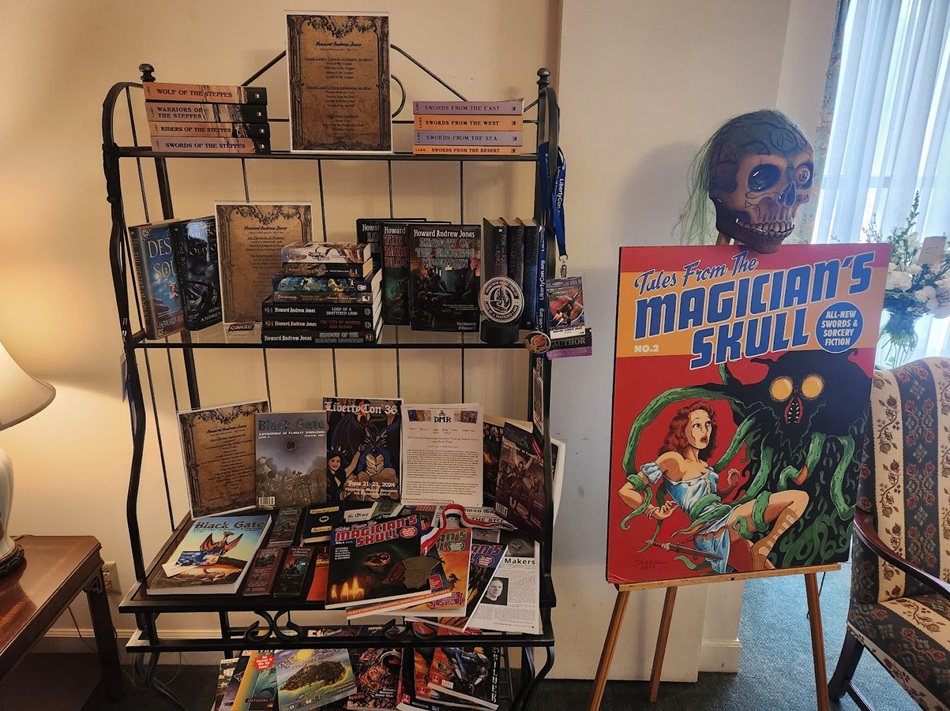 The Writing Display of Howard Andrew Jones at his Celebration of Life, February 22, 2025
Goodreads Sword & Sorcery Group
The Writing Display of Howard Andrew Jones at his Celebration of Life, February 22, 2025
Goodreads Sword & Sorcery Group
The Goodreads S&S Group began in 2012, initiated by Periklis Begzos. We struck a friendship, and I became a lead moderator for 10 years before getting pulled into organizing the Gen Con Writers Symposium over the Covid era (not ironically, a role that followed after HAJ encouraged me to volunteer for the convention). Anyway, S&S GR group still exists, but activity has waned. Regardless, I share a moving anecdote from Periklis that captures how Howard helped others and they helped him:
“Regarding Howard’s touch, I remember discovering his book “The Desert of Souls” in early 2012. I loved it. I was following Black Gate magazine and what struck me the most was the love for the culture (of both S&S and adventure/pulp fiction) that Howard spread. At the same time he announced a competition for naming the Dabir & Asim series. I submitted the name “The Chronicles of Sword and Sand” and was awestruck when it won. Along came a gift pack of all of Howard’s published works, with a printed map and a lovely letter from him. It really pulled me from a dark place I was going around that time and allowed me to start the public Goodreads group about sword and sorcery. So I would think that Howard’s generosity of character and his altruistic involvement with all things Sword & Sorcery are keeping inspired to this day.” Periklis Begzos
Harold Lamb is the ‘Grandfather of S&S’?Perusing HAJ’s comments in the Goodreads Sword and Sorcery Group, I came across this gem that showcases his love for Lamb and S&S.
I stumbled across one of his Cossack collections when I was in high school and was immediately reminded of one of the Leiber collections of Fafhrd and Mouser stories. Not because Khlit the Cossack is a thief and bravo, because he isn’t, but because both Lamb and Leiber wrote serial stories with continuing characters — almost like a TV series — stuffed full of action and adventure and sense of wonder.
I’ve argued at length, in many places, that Lamb is the unsung grandfather of sword-and-sorcery, because he’s got nearly EVERYTHING except the imaginary world and real sorcery. He occasionally (very occasionally) suggests the fantastic. And he is one of the very first to write adventure fiction with a mostly modern feel. He’s still compulsively readable today. Combine that with his laconic style and pacing and sense of adventure — not to mention surprise — and you have something phenomenal.
I was astonished when I discovered how many of his stories that had not been collected were excellent. His work isn’t like, say an obscure rock band that’s only good when you listen to their greatest hits. Even many of his deep album tracks are strong. I dreamed that one day I could find them all and read them. Slowly I did. And because the only job I could find in the economic downturn of the ’90s was as a third shift proofreader, I ended up becoming an editor, which made it possible for me to cold call Bison Books and pitch the collections. I knew how to talk “book” in the language of “editor” and I’d amassed a sizable collection of obscure Lamb texts by that point. Because I loved his stories I’d accidentally become an expert, and because of my accidental training I was perfectly positioned to make it happen. Serendipity. — HAJ 2016, Goodreads Threads
Magazine Editing and Honing A New EdgeIn 2005-2007, Howard edited the first six 6 e-zones of Flashing Swords (this link goes to the archived internet that offers the PDFs! Go get them!). How influential can an e-zine be? Read the introduction of Return of the Sword where esteemed heroic fiction champion Jason M Waltz lists Flashing Swords as one of his inspirations (and provided Jason an opportunity to become an assistant editor; Rogue Blades Entertainment and Foundation evolved from Jason’s own passion to build an S&S community).
In 2006, Howard moved along to take a position as Associate Editor at Black Gate. As John O’Neill mentions in his tribute and oral remembrance, Howard quickly rose from exuberant writer and associate editor to Black Gate’s first Managing Editor. HAJ grew the website driven by a passion to get fresh content posted daily and enlisted over thirty staff. In 2016 Black Gate Magazine was awarded a World Fantasy Award, a recognition that John O’Neill has said reflects Howard’s devotion (keep in mind, John is also a superb, understated mentor/hero who deflects compliments).
In 2008, as Managing Editor at Black Gate, HAJ posted his “manifesto” regarding a resurgence brewing in Sword & Sorcery fiction: Honing A New Edge Part 1 & Part 2 (these originally appeared in the introductory editorials Issue 3 & 4 as “The New Edge”). Excerpts are below. This sentiment resonated with many authors and editors, and a decade after its posting, directly inspired the creation of New Edge Sword & Sorcery Magazine (though editor Oliver Brackenbury has a slightly different definition than that of HAJ, read Oliver’s interview on BG for more). Incidentally, New Edge S&S 2025 has another crowdfunding running now, check out the link for the new Jirel of Joiry.
Traditional S&S Heroes (from Honing A New Edge Part 1)The protagonists in sword-and-sorcery fiction are most often thieves, mercenaries, or barbarians struggling not for worlds or kingdoms, but for their own gain or mere survival. They are rebels against authority, skeptical of civilization and its rulers and adherents. While the strengths and skills of sword-and-sorcery heroes are romanticized, their exploits take place on a very different stage from one where lovely princesses, dashing nobles, and prophesied saviors are cast as the leads. Sword-and-sorcery heroes face more immediate problems than those of questing kings. They are cousins of the lone gunslingers of American westerns and the wandering samurai of Japanese folklore, traveling through the wilderness to right wrongs or simply to earn food, shelter, and coin. Unknown or hazardous lands are an essential ingredient of the genre, and if its protagonists should chance upon inhabited lands, they are often strangers to either the culture or civilization itself. — HAJ 2008
Being Heroic (from Honing A New Edge Part 2 )We’ve been conditioned to believe that there aren’t any real heroes and that everyone’s in it for themselves; we’ve been trained to be skeptical and ironic and detached and sarcastic and hip. Yet even as we sneer and laugh with our friends, we know it’s a lie. Heroes really are out there. They’ve lived and breathed and sacrificed right here on this very Earth, and some of them are still at it. Students of history know them. Sometimes we can even find them covered by our local news stations. Stories of heroes, not of dejected mopers, have inspired us since the dawn of humanity, and we should not be embarrassed if they continue to fire our imagination. — HAJ 2008
HAJ: So what are those New Edge guiding principles? Briefly:-
A hardboiled tone — as in terse and unsentimental
-
Exotic settings and/or settings that live — as in NOT faux Tolkien (if the settings echo Tolkien or other writers then they must be twisted or seen from some new perspective)
-
Evoking a sense of wonder — magic is never banal or easy, the fantastic should not be mundane
-
High energy storytelling — as in fast and without padding
From a 2012 editorial post, we learn HAJ’s gratitude for being part of a community.
We wouldn’t be working so hard to get published in this genre if we didn’t love the genre, and I can trace a lot of my success back to actually becoming involved in it (I already posted about the exact steps to my book deal a year or two ago). Corresponding with other writers, writing reviews for genre sites, reading slush, writing editorials, editing for ‘zines and magazines. Eventually, a whole lot of people had heard of me, so that I wasn’t a complete unknown when it got to be time to try to promote my books.
I didn’t know that was going to happen — I just couldn’t stay away from fantasy fiction, particularly heroic fiction. But it DID happen, and even though every author’s journey is a little different, surely there’s some lessons from this story some of you out there could find useful. — HAJ 2012
When you begin your writing career, you’re joining a community — HAJWriting is a lonely business and I wanted to meet some kindred spirits. What I didn’t realize was that I was also forming a network of friends and allies, AKA “networking.” I dislike that word, though, because it suggests that one is cold-bloodedly setting forth to make friends to climb the ladder, probably before callously putting them aside for new and better and more powerful contacts as one advances. I realize now that I was becoming part of a writing community.
Many writers grow up thinking of the writing profession as a noble romantic one, where we sit alone in a tower room with our raven on a bust of Poe and a cat in our lap. Well, okay, I never pictured that, exactly, but I expected that I would write stuff and I just had to send it out until some editor finally printed me, probably sooner rather than later. As I became a regular at various magazines, I realized just how rewarding it was to be exchanging letters with editors and fellow authors and even readers from the various magazines. After I jumped the editorial fence, I started to comprehend that part of what you’re doing with a magazine is helping to build a community of writers and readers. — HAJ 2012
The Evil Skull versus the Heroic HanuvarIn 2017 (Kickstarter Link), Howard teamed with Joseph Goodman (Goodman Games) to create Tales from the Magizian’s Skull (as Joseph describes in his tribute).
Howard shared my appreciation of how fiction can inspire great gaming. We were both fans of several of the same things: D&D and DCC RPG, Appendix N, and Weird Tales, the publication that first published many of the Appendix N authors. We decided to start a fiction magazine together. From there we created Tales From The Magician’s Skull. The issues of that magazine that I published are among the Goodman Games publications of which I am most proud. Tales From The Magician’s Skull stands out from every other periodical in its category for its titular hero (or perhaps villain?), who would not exist were it not for the weird melding of Howard’s and my brains. Somehow our mutual creativity synthesized this bizarre character who seemed completely real to both of us. The Magician’s Skull was so integral to our mutual imaginations that we tag-teamed to write the editorials, articles, and memorandums attributed to the Skull. — JG 2025
The magazine moved ownership from Goodman Games to Outland in 2024 (here is their KS page for issues 13+ and their current store). The magazine’s run was a creative fusion of Howard and Joseph, but Howard was the frontman under the mask and editor. I shared my thoughts within the Science Fiction Writers of America (SFWA) obituary, and echo them here since they capture how Howard and the Skull persona complemented each other:
Howard’s Skull’s persona resonated since it was the antithesis of him. Whereas the villainous champion of the titular magazine spitefully called his readers ‘mortal dogs’ and regularly ‘immolated’ his interns, the man behind the mask was known to be overly gracious, coaching aspiring, mature, and professional writers in myriad conventions, editing, blogs… for decades! He mentored tirelessly even as his body failed. A week before he was diagnosed with terminal cancer, he improvised a personalized ‘Hey Jude’ song at Gen Con Writers Symposium to inspire me on the piano beside the green room, and the lyrics motivate/haunt me continuously. How did he exude so much vitality?
His Hanuvar character embodies Howard more accurately, a veteran striving to save his shattered family and reunite his community (refreshing compared to the flood of immoral, vengeful protagonists available). Howard could strike a friendship up in minutes, and combined with his passion for storytelling, [this] makes him one to be remembered as much as for his heroes as for his own heroism. Howard was the quintessential role model. I imagine him inspiring us now in our time of mourning: ‘Behold, mortal readers, do your morning stretches, carry on, and realize the stories inside you. Swords together!’ — SEL
A Confluence of S&S Community Builders In 2022, I reported on the S&S Rogues in the House podcast for Black Gate. As the Rogues moved beyond podcasts to build the Sword & Sorcery community, they started publishing anthologies including the just-released A Book of Blades. With my Event Coordinator role for the Gen Con Writers Symposium, I did my best to gather the Rogues and other contributors to A Book of Blades on several panels. Collected were the Rogues in the House podcasters, HAJ of the Skull magazine, Jason Ray Carney of Whetstone Amateur Sword & Sorcery Magazine, and myself. We gathered in Marriott Ballroom #4 to record this special session. At 6:45 min:sec, the Skull crashes the party and awards his only named intern an award. Click here to listen: The Rogues on Hallowed Ground (link to Aug 8-2022 podcast episode)“Rogues, old and new, meet at the mecca called Gen Con. In this very special episode, Deane Geiken and Matt John are joined by Howard Andrew Jones, Seth Lindberg, Steve Diamond, Sean CW Korsgaard, Jason Ray Carney, and *shudders* The Magician’s Skull himself. Topics include sword and sorcery (of course) as well as our “top picks” from Gen Con.”
 2023 Gen Con, the Skull with Joseph Goodman, Matt John, Seth Lindberg
Day of Might
2023 Gen Con, the Skull with Joseph Goodman, Matt John, Seth Lindberg
Day of Might
The Skull is responsible for creating the first Sword & Sorcery holiday to be celebrated every October 23rd. A cartoon excerpt from Tales from the Magician’s Skull explains the inception (below) and Skull TV captures essential broadcasting of the initial days.
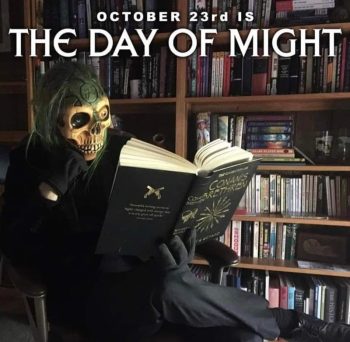

I have been grateful to HAJ for many years, from being a fan of his S&S blogs and appearances at World Con 2010, to meeting him at Gen Con and having him coach me into volunteering at the Writers Symposium ~2017 (which grew into me chairing it in 2023), for bridging the connection to John O’Neill to edit for Black Gate online magazine (~2019 onward), and for being able to intern for his magazine Tales From the Magician’s Skull as acquisition editor and for being a social media intern for the Skull (~2022).
The outpouring of memorials speaks to HAJ’s character and influence. Each instance, even the shorter obituaries, amplifies his life and reveals nuances. Below I list several so I, and anyone visiting here, can learn more about the man we miss. There are many more tributes than those listed below. More may be added after the original posting date as I track those down.
Did you know Howard… was once a TV cameraman? Created an official Walk Through Guide for a Castlevania game? Coined New Edge Sword & Sorcery?- Locus: abbreviated verionHoward Andrew Jones (1968-2025); longer version by CSE Cooney, John O’Neill, John Hocking, Matthew John, Scott Oden) available in Issue 769 also inside the celebration display p16.
- SFWA: In Memoriam: Howard Andrew Jones [John O’Neill, SE Lindberg, Martha Wells, Sean CW Korsgaard]
- Joseph Goodman (Skull publisher) A Tribute to Howard Andrew Jones
- John ONeill (Black Gate): Howard Andrew Jones, July 19, 1968 – January 16, 2025
- Jason Ray Carney: Howard Andrew Jones, a Mentee’s Perspective
- Bob Byrne An Important Life – Howard Andrew Jones (1968 – 2025)
- Brian Murphy: Rest in peace, Howard Andrew Jones
- Sean CW Korsgaard This is one of the hardest things I’ve had to write in my career. Howard Andrew Jones is dead
- Mark Rigney (Celebration of Life farewell)
- Greg Mele: “Swords Together, buddy” Private Facebook Post
- Matt John — Devastated to learn my friend, Howard Andrew Jones, has passed.
- Deuce Richardson (DMR) Howard Andrew Jones Has Fought His Last Battle
- Vanessa Armstrong Author Howard Andrew Jones Passes Away at Age 56
- Michael Grossberg Acclaimed fantasy writer and Prometheus finalist Howard Andrew Jones, R.I.P.
- Paizo (Pathfinder) Paizo Remembers Howard Andrew Jones
- Morgan Holmes Remembering Howard A. Jones
- Keith West RIP, Howard Andrew Jones
 Howard Andrew Jones’ Office in Evansville
Heroes really are out there. They’ve lived and breathed and sacrificed right here on this very Earth, and some of them are still at it. Students of history know them. Sometimes we can even find them covered by our local news stations. Stories of heroes, not of dejected mopers, have inspired us since the dawn of humanity, and we should not be embarrassed if they continue to fire our imagination. — HAJ 2008
Howard Andrew Jones’ Office in Evansville
Heroes really are out there. They’ve lived and breathed and sacrificed right here on this very Earth, and some of them are still at it. Students of history know them. Sometimes we can even find them covered by our local news stations. Stories of heroes, not of dejected mopers, have inspired us since the dawn of humanity, and we should not be embarrassed if they continue to fire our imagination. — HAJ 2008
S.E. Lindberg is a Managing Editor at Black Gate, regularly reviewing books and interviewing authors on the topic of “Beauty & Art in Weird-Fantasy Fiction.” He has taken lead roles organizing the Gen Con Writers’ Symposium (chairing it in 2023), is the lead moderator of the Goodreads Sword & Sorcery Group and was an intern for Tales from the Magician’s Skull magazine. As for crafting stories, he has contributed eight entries across Perseid Press’s Heroes in Hell and Heroika series, and has an entry in Weirdbook Annual #3: Zombies. He independently publishes novels under the banner Dyscrasia Fiction; short stories of Dyscrasia Fiction have appeared in Whetstone, Swords & Sorcery online magazine, Rogues In the House Podcast’s A Book of Blades Vol I and Vol II, DMR’s Terra Incognita, and the 9th issue of Tales From the Magician’s Skull.
Lights Out - Book Review by Voodoo Bride
 Lights Out (Into Darkness #1)by Navessa Allen
Lights Out (Into Darkness #1)by Navessa AllenWhat is it about:I want someone with a soul as black as night. Someone who would burn the world down for me and not lose a single minute of sleep over it.
Trauma nurse Aly Cappellucci doesn’t need any more kinks. She likes the one she’s landed on just fine. To her, nothing could top the masked men she follows online. Unless one of those men was shirtless, heavily tattooed, and waiting for her in her bedroom. She dreams about being hunted by one in particular, of him chasing her down and doing deliciously dark things to her willing body. She never could have guessed that by sending one drunken text, those dreams would become her new reality.
I want things most people don’t, craving darkness and depravity instead of light and love.
Josh Hammond has spent his life avoiding the limelight, but his online persona is another story. At night, he posts masked thirst traps for his millions of fans to drool over, but one follower has caught his eye: Aly. After reading a comment begging him to break into her house wearing a mask, he decides to take her up on her offer.
Together, Aly and Josh live out their darkest fantasies, unaware that Aly has captured the attention of someone else. Someone with far more sinister intentions than a little light stalking. As Josh turns from predator to protector and the stakes heighten, he must ask himself how far he’s willing to go for the woman he’s obsessed with.
What did Voodoo Bride think of it:*Might be a tiny bit spoilery*
Either I'm more depraved than I thought, or there needs to be a serious discussion about what a Dark Romance is.
Because this wasn't dark at all in my opinion!
Not that that was a bad thing: I haven't laughed so much while reading a Romance in a long time. And not because the story is laughable, but because it really is meant to be funny.
I liked Aly and Josh from the start. Josh is a bit of a social disaster, but otherwise they're both just really fun people. I enjoyed learning more about them and seeing them fall for each other.
There were two minor annoyances:1 - Even though their backstories were entertaining, I didn't like it that those were used as an explanation for their kinks. You don't need a trauma or tragic event to enjoy kinks.2 - Saying "No safe word. Just say stop, and I'll stop." = a safe word!!!!!But those were minor as I said. I could easily put it aside for the sake of the story.
All in all I had a great time with this, and even Sullivan got invested when real danger was introduced to make things a bit more suspenseful. He also really liked Fred, the cat.
You bet we will get hold of the next book.
Why should you read it:It's a very enjoyable Dark Romance
Novella Review: Murder by Memory by Olivia Waite
I received a review copy from the publisher. This does not affect the contents of my review and all opinions are my own.
 Murder by Memory by Olivia Waite
Murder by Memory by Olivia Waite
Mogsy’s Rating: 3 of 5 stars
Genre: Science Fiction, Mystery
Series: Book 1 of Dorothy Gentleman
Publisher: Tordotcom (March 18, 2025)
Length: 325 pages
Author Information: Website | Twitter
I’d never read Olivia Waite before, but apparently she’s known for her romance writing. In Murder by Memory, she’s managed to successfully blend elements of a love story with a cozy mystery set on a generation ship—not genres you often see thrown together in the same mix. Still, while tackling it in novella form may have made this one a quick read, I think the shorter length probably hobbled its potential.
The story kicks off when Dorothy Gentleman, detective on starship H.M.S. Fairweather, wakes up unexpectedly in the middle of their centuries-long journey. In addition to thousands of passengers, the vessel is also carrying a vast digital archive, the “Library”, where their memories have been uploaded and stored in “books.” These books can be updated at any time, ready to be downloaded into a person’s new body that is provided once their old one dies.
When Dorothy awakens, however, she had not expected to be downloaded into a new body so soon, for she had chosen to shelve her memories for a few years. Not only that, but the new body she finds herself in is not her own, but a stranger’s named Gloria. The ship’s A.I. informs our protagonist that there has been a death on the ship, and someone has also been deleting memory archives from the Library. Along with the unusual circumstances she now finds herself in, these incidents are more than likely connected. To solve the murder and figure out why her memory book was erased—which has resulted her being in the wrong body—Dorothy must step into her detective shoes and investigate, using her skills and the element of surprise to her advantage.
Without a doubt, the greatest strength in Murder by Memory is the world-building. While the concept of effective immortality by uploading the consciousness and downloading it into new bodies isn’t new, I have never seen it used in a cozy setting like this. In fact, the stories I’ve read that are set on generation ships tend not to be very pleasant, weighed down by themes like scarcity and uncertainty. But the world Waite has created is perfectly copacetic. Which is why the idea of a murder, especially one like this, feels like such a big deal.
The mystery plot itself was also solid, but unfortunately, the constraints of the novella’s short length were noticeable. There was no room for the story to be anything but straightforward, making the investigation feel rushed and lacking in complexity. While we moved quickly from clue to clue, the absence of any intrigue left the resolution feeling a bit sudden and too easy. Likewise, Dorothy was an enjoyable protagonist, and there were certainly moments of humor reading about this older lady adjusting to a more youthful body, but the story’s brevity also meant that her development was somewhat sparse, and I barely registered any of the side characters.
Ultimately, Murder by Memory was a fun read, but despite some of its unique qualities, I doubt it will leave a lasting impression. That said, as the opening volume of a new series, I think it has potential. Over time, I can see future sequels building upon each other, fleshing out the world and bringing more depth to Dorothy’s character. And if these episodes will be as short and sweet as this one, I’ll be keeping an eye out for the next book and hoping it expands on the foundations laid here.
![]()
![]()
Goth Chick News: Corpses, Monsters and a Giraffe Onesy – Hitting the Road to TransWorld 2025
 TransWorld’s Halloween & Attractions Show 2025
TransWorld’s Halloween & Attractions Show 2025
Around this time every year, Black Gate photog Chris Z and I pack up the car for the 10-hour-round-trip from Chicago to St. Louis to attend the TransWorld Haunted Attractions Show. This event not only kicks off the spooky season for the new year but never fails to produce at least one memorable adventure. From Fireball shots to epic snowstorms, to celebrity encounters, I can always count on our annual road trip to produce stories that will easily carry me through a year’s worth of cocktail-party small talk.
This year was no exception.
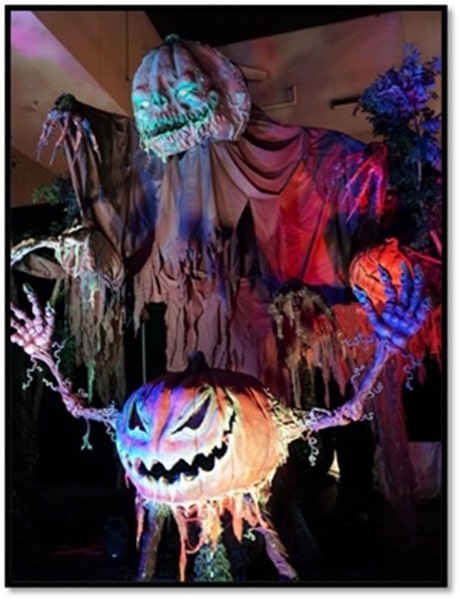
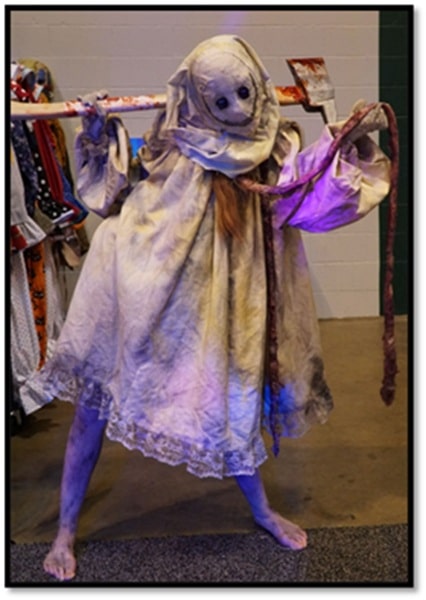
Seen at the TransWorld Halloween & Attractions Show 2025. Photos by Chris Z
For a start, our odyssey begins with me picking up Chris Z at 5am to ensure we are in St. Louis when the show doors open at 10. This has been the standard operating procedure for the eighteen years we have been covering this show, except for the couple of years TransWorld was held here in Chicago. Every year, Chris Z complains about the early pickup time, threatening to show up in his pajamas and sleep the entire five hours; and every year I tell him to nut-up and promise to stock the car with Mountain Dew.
So, last weekend at 5am I roll up into his driveway, noticing there is some kind of cord laying in front of his garage door, and remind myself to tell him when he comes to the car. At that moment, the darkness of the suburban neighborhood is shattered by a disco light display worthy of Saturday Night Fever. My stunned brain seized up, my mouth dropped open, and before I could figure out what the heck was happening, the garage door lifted to reveal Chris Z in a giraffe onesy.
As I have no further words to describe this, so here…


Chris Z in a onesy
Yes, apparently Amazon really does have everything.
Chris Z loads his camera gear in the back seat, gets in, and curls up – all in silence. An hour later when we stop to recaffeinate, he strolls into the Starbucks in said onesy and blithely orders like this is something he does every day. To the credit of the baristas, they just looked at each other and kept right on working. Back at the car, Chris Z shed the onesy saying only that it was making him too hot.
…sigh.
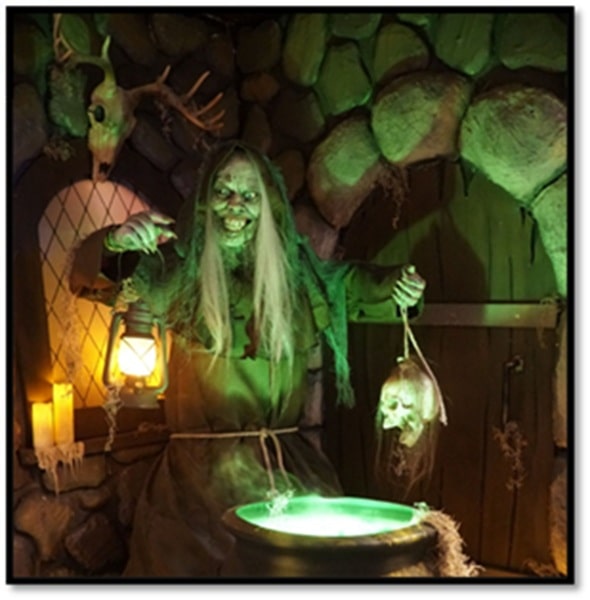

Photos by Chris Z
Now, about the TransWorld show and why thousands of Halloween tradespeople fly from all over North America to get their spooky on in February.
TransWorld is an “industry only” event not open to the public. It brings together professional haunt operators and the suppliers of everything from costumes and makeup, to $20K special effects.
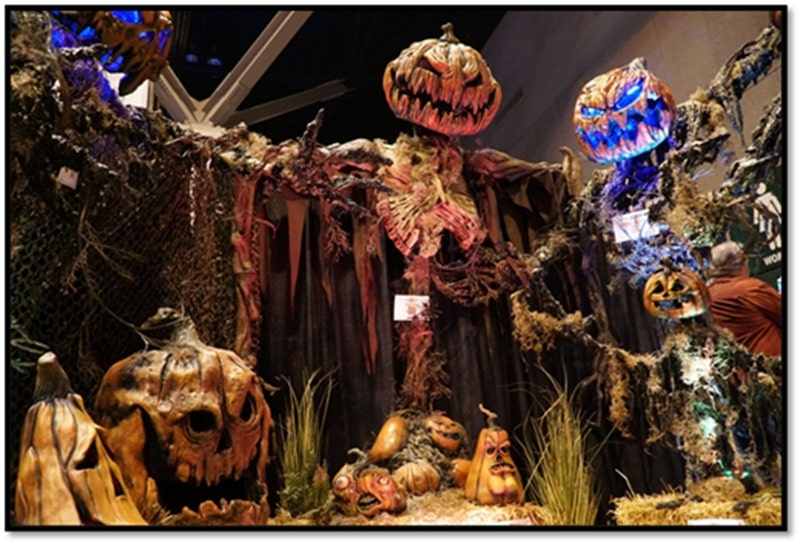 Scenes from TransWorld’s Halloween & Attractions Show 2025
Scenes from TransWorld’s Halloween & Attractions Show 2025
Ever wonder where amusement parks like Cedar Point and Great America, or big-name haunted attractions get their gear? TransWorld is the place, and with the haunt industry estimated at $30 billion annually, the vendors who have booths at TransWorld are the absolute real deal. Also, since creating and shipping all these scares takes time, the flurry of activity happens in February to ensure everything is in place by fall.
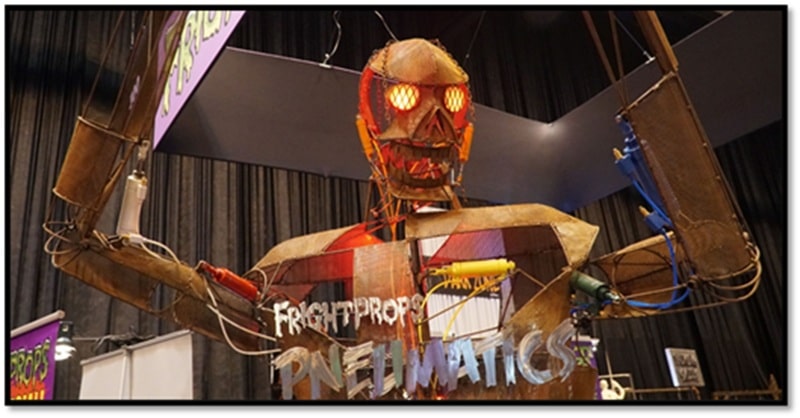 Frightprops Pneumatics
Frightprops Pneumatics
Walking into TransWorld, held at the Americas Center is stepping into 500,000 square feet of creativity and horror. Imagine rows upon rows of booths showcasing hyper-realistic props, cutting-edge animatronics, custom soundscapes, and theatrical-grade special effects. One of the highlights of each year is getting an early look at the new technology that keeps the haunted attraction industry fresh and terrifying. Innovations like AI-driven scares, augmented reality overlays, and hyper-detailed silicone masks demonstrate the evolution of horror craftsmanship.
TransWorld is more than just a trade show; it’s a masterclass in the haunt industry. The event features an array of seminars, workshops, and panels led by industry veterans. Topics range from the art of creating compelling narratives for haunted houses to practical advice on marketing, ticketing, and safety protocols.
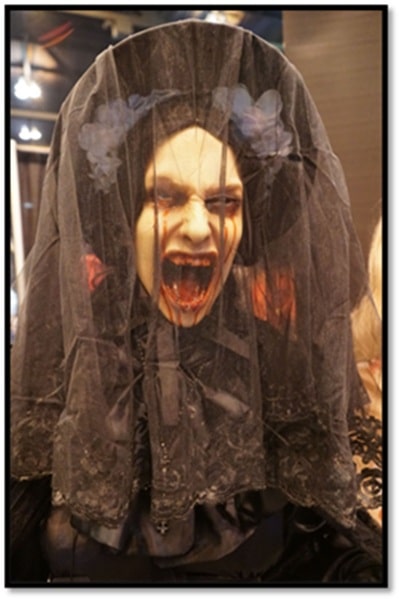
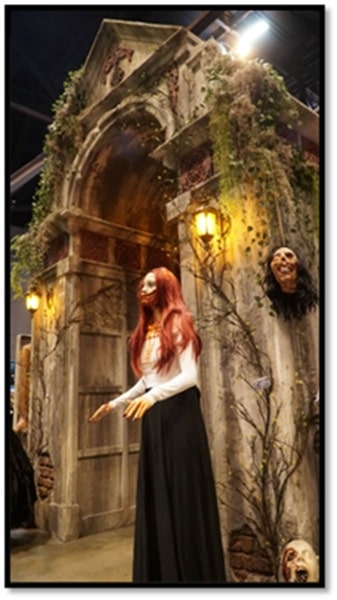
Seen at TransWorld. Photos by Chris Z
For haunters who want to experience the thrills firsthand, the event hosts live demonstrations and walkthrough attractions. These mini-haunts showcase the latest in set design, scare techniques, and interactive storytelling. Walking through these exhibits is like getting a sneak peek at the nightmares that will soon populate attractions nationwide.
Perhaps the most compelling aspect of TransWorld is the community it fosters. Chris Z and I consider it our annual “family reunion” where we connect with artists we’ve covered for nearly two decades and get the scoop on their newest ventures.
We couldn’t kick off spooky season without checking in with my long-time goth boy-band crushes, Ed and Gavin of Midnight Syndicate. Best known for their dark, atmospheric soundtracks they have become staples in the haunted attraction industry.
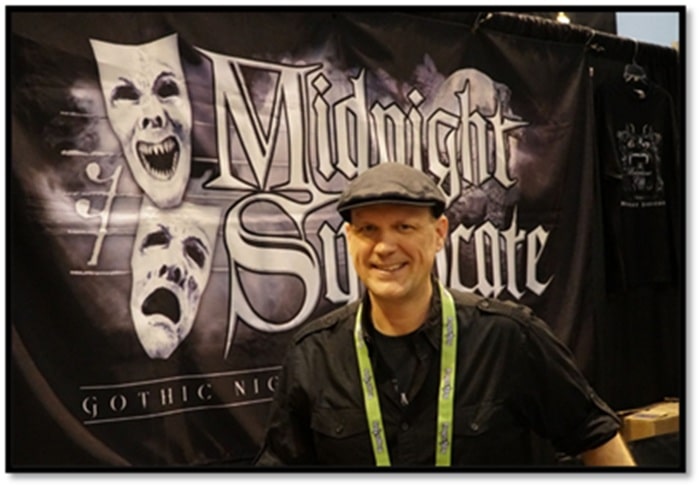 Goth Boy-Band Crush: Midnight Syndicate
Goth Boy-Band Crush: Midnight Syndicate
Since their formation in 1997, Midnight Syndicate has created the soundtrack for haunt season, providing music for Universal Studios Halloween Horror Nights and hosting their own stage show at Cedar Point’s Halloweekends.. We absolutely love Ed and Gavin’s music and were excited to learn they have a new album coming out later this year. We are always honored to get an early listen, so stand by for more.
 Demski Creations
Demski Creations
We also checked in with Brian Demski of Demski Creations. Brian is a seasoned artist with over two decades of specializing in creature special effects, custom prop fabrication, and scenic design. He has contributed to feature films, television, music videos, and haunted attractions, and his work is characterized by a macabre aesthetic, often incorporating steampunk elements. Having first interviewed Brian for Black Gate back in 2011, when I acquired my first Demski original, it has been incredible seeing the evolution of his talent first hand.
Last but never least we had a chance to catch up with John Weisgerber, owner of the Gemini Company. John didn’t have a booth this year, but we loved hearing about his latest creations. The Gemini Company specializes in museum-quality replicas sculpted and/or molded from actual specimens and cast in high quality materials and resins. Gemini pieces can be seen in shows such as American Horror Story and Mysteries at the Museum and I am the proud owner of a very realistic shrunken head which attends all my Teams meetings. Gemini also has a great Etsy page and I’m eyeballing that evil little doll from Trilogy of Terror.
 That creepy little doll from Trilogy of Terror (replica by The Gemini Company)
That creepy little doll from Trilogy of Terror (replica by The Gemini Company)
So spooky season 2025 has officially kicked off and I couldn’t be more excited. By the way, I never considered a giraffe to be an element of horror – until now.
Spotlight on “When We Were Real” by Daryl Gregory
When We Were Real is a madcap adventure of two friends on a cross-country bus…
The post Spotlight on “When We Were Real” by Daryl Gregory appeared first on LitStack.
On McPig's Wishlist - A Dagger of Lightning
 A Dagger of Lightningby Meredith R. Lyons
A Dagger of Lightningby Meredith R. LyonsLet's get one thing straight: I am not your chosen one.
Forty-five-year-old Imogen has always struggled to fit in, never finding her passion in life. And while that may include having cold feet in her impending nuptials, that doesn't mean she's ready to ditch planet Earth—and her entire life—completely.
When Imogen is kidnapped by an alien prince in disguise, there’s nothing she can do to stop him. He’s sidhe—a being with powerful abilities—and he’s grown up used to getting what he wants. The prince is convinced Imogen will fall in love with him, and that her new powers, once she’s turned sidhe, will help his country win a centuries-old feud.
With the help of the prince’s much more tolerable brother, Imogen starts to get her feet back under her, but even he can’t protect her from those who would use her for her powers. If Imogen can’t find a way to fight for herself, she’ll become a pawn in a world that has already decided what she’s going to be.
Expected publication April 1, 2025
And Now For Something Completely Different: The Borrowers, by Mary Norton
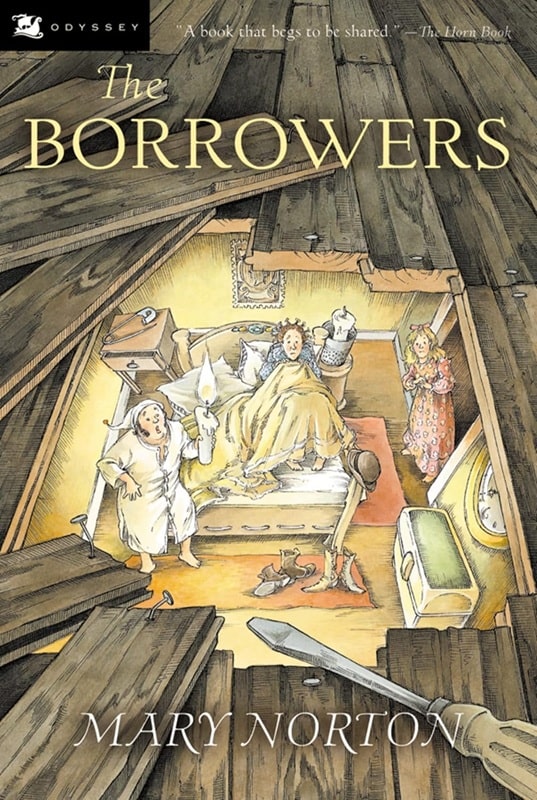

The Borrowers and The Borrowers Afield, by Mary Norton
(Odyssey/Harcourt, January 1998). Covers by Marla Frazee
I’ve done four posts in a row on Edgar Rice Burroughs, with more to come. But right now it’s time for a change of pace.
It’s going to be a big change for this particular post. It’s about The Borrowers. In my late teens, after I learned Andre Norton was a woman, someone told me she’d written books under her own name of Mary Norton, and that one was called The Borrowers. Turns out this wasn’t true; her original name was Alice Mary Norton, although she changed it legally to Andre Alice Norton in 1934. This was in the late 1970s, pre-internet, and I believed Andre Norton wrote The Borrowers for several years. It added to her charm for a while because I’d read The Borrowers when I was 11 or 12 and adored it.
The Borrowers may seem pretty far afield from Sword & Planet fiction, but the story of little people living in human houses and borrowing things from them, which would explain why things got “lost,” inspired my imagination and I invented many stories of myself shrunk down to that size and adventuring. After I wrote Swords of Talera, my first S&P novel, I toyed with the idea of writing an S&P story with borrower size characters but never did. Many many years later I discovered a graphic novel from DC called Sword of the Atom, which somewhat scratched that itch for me. (More on that later.)
[Click the images for non-Borrower-sized versions.]
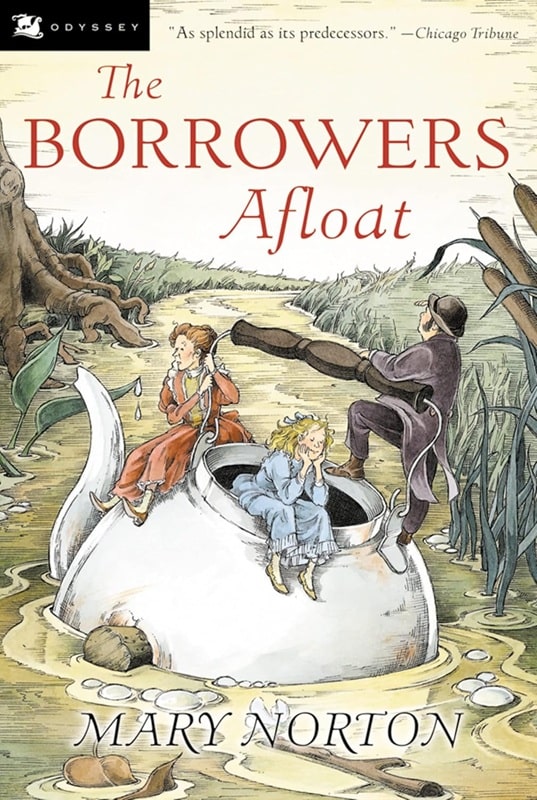
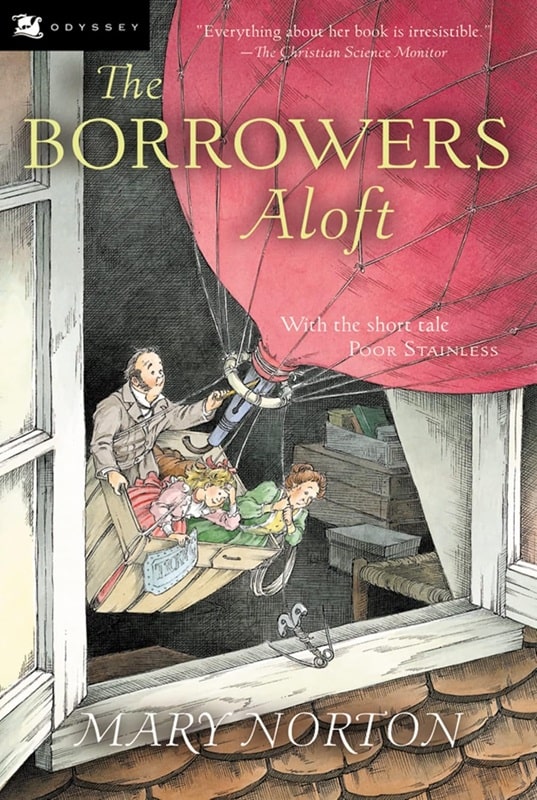
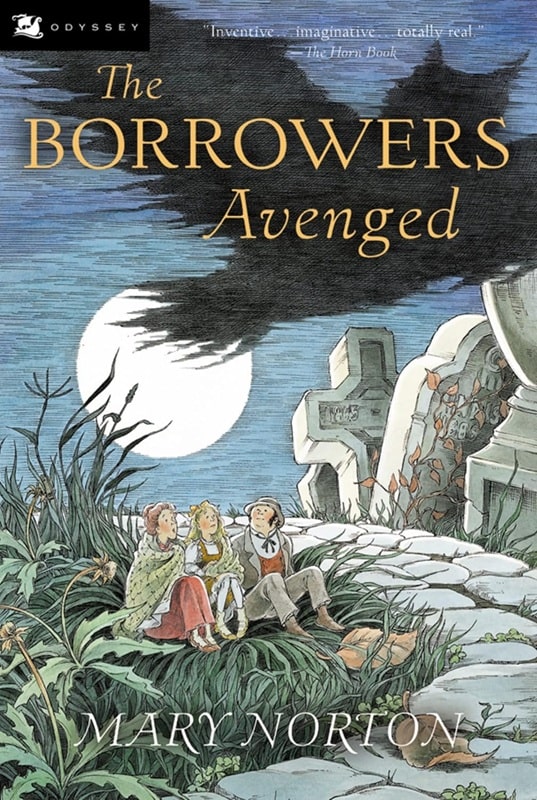
The Borrowers Afloat, The Borrowers Aloft, and The Borrowers Avenged
(Odyssey/Harcourt, January 1998). Covers by Marla Frazee
I got The Borrowers from our local library and only found out as an adult in my thirties that there were three later books in the series. These are: The Borrowers Afield, Afloat, and Aloft. I still remember being irritated at our library for not having those too. I would have devoured them.
This happened to me with other series I would have read more of at the time, including The Three Investigators (I thought there were just 2), The Hardy Boys (I only saw 3), and Doc Savage (I thought there was only a couple).
I picked up my own copy of The Borrowers many years ago, and later got The Borrowers Afloat, but after thinking about this post I went and ordered Afield and Aloft, and then discovered that Mary Norton wrote a fifth sequel 20 years after Aloft called The Borrowers Avenged. I ordered that one too. I just finished reading Afield and Aloft and they had all the charm and fun of the original.
I’m reading Avenged now. The first two I have are ex-library copies but I bought the other three are new. The older ex-library editions have wonderful covers and interior illustrations by Beth and Joe Krush. I particularly love The Borrowers Afield cover, by Marla Frazee. Totally ignites my imagination.
Charles Gramlich administers The Swords & Planet League group on Facebook, where this post first appeared. His last article for Black Gate was The Fiction of Edgar Rice Burroughs, Part IV: The Hollow Earth and Pellucidar.
7 Author Shoutouts | Authors We Love To Recommend
Here are 7 Author Shoutouts for this week. Find your favorite author or discover an…
The post 7 Author Shoutouts | Authors We Love To Recommend appeared first on LitStack.
Alien Ghostship - Book Review by Voodoo Bride
 Alien Ghostshipby Bella Blair
Alien Ghostshipby Bella BlairWhat is it about:Jane: While scouting my assigned sector in our galaxy, I come upon an abandoned alien ship. A Ghostship. Excited to explore the deserted vessel, things soon turn strange as an eerie mist follows me wherever I go, even showing me the way to a cabin that appears to have been left in a hurry. Soon I discover, that I'm not only unable to leave the Alien Ghostship, but I begin to dream of a handssome, alien stranger. Is he the guy who left this ship in an obvious haste?
WREN: Thanks to my copilot's betrayal, I have been a prisoner in this cave for I don't know how long. My only hope is that my prototype ship has left to find help, otherwise I'm afraid I will be doomed in here. One morning my tablet announces that somebody has boarded my ship. A woman of a species I have never seen before. Did she board my ship to steal it or to get help? And what is that mist that seems to follow her everywhere? And why do I suddenly begin dreaming of her? So real it is as if she were sitting right next to me. So alluring that all I care about is being with her.
What did Voodoo Bride think of it:I got this as a freebie for signing up to Bella Blair's newsletter
This is a nice read.
It could have used a bit more editing, but I liked the story well enough to overlook the typo's and missing words.
The romance is fast, but enjoyable. It is a bit of a puzzle how the two are noticing and feeling each other, but that added a bit of suspense to it.
The ending was a bit too obviously trying to shove in lead characters of other books, but all in all ths was a pleasant read. I got several other freebies for signing up, all part of different series by Blair. I might try one of those to see if there's a series/world that captures me.
Why should you read it:It's a nice SciFi Romance.
“Worms of the Earth” and Robert E. Howard’s Ultimate Triumph
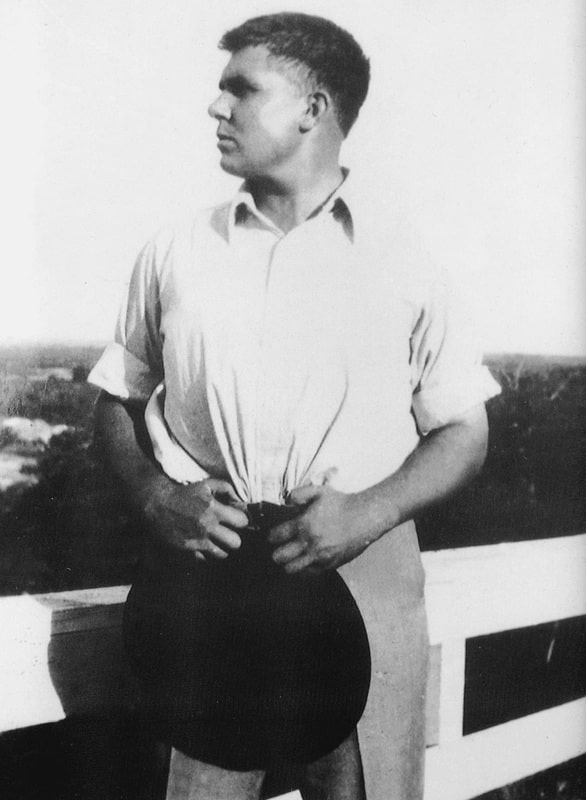
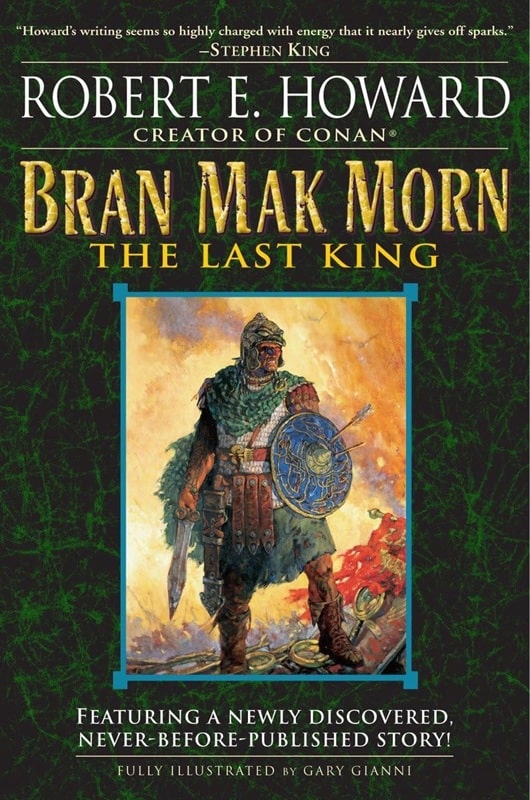
Robert E. Howard in a photo sent to H.P. Lovecraft in 1931,
and Bran Mak Morn: The Last King (Del Rey, May 31, 2005)
January 22, 2025 was the 119th birthday of Robert E. Howard, my favorite author. The works of this great author resonate with countless fans to this day.
“Worms of the Earth” is my favorite story by Robert E. Howard. It features Bran Mak Morn, the last king of the Picts.
Howard was fascinated with Picts, his conception of whom was largely mythological, with splashes of real world history. The Picts in his stories span Kull, Conan, Bran, James Allison, and more.
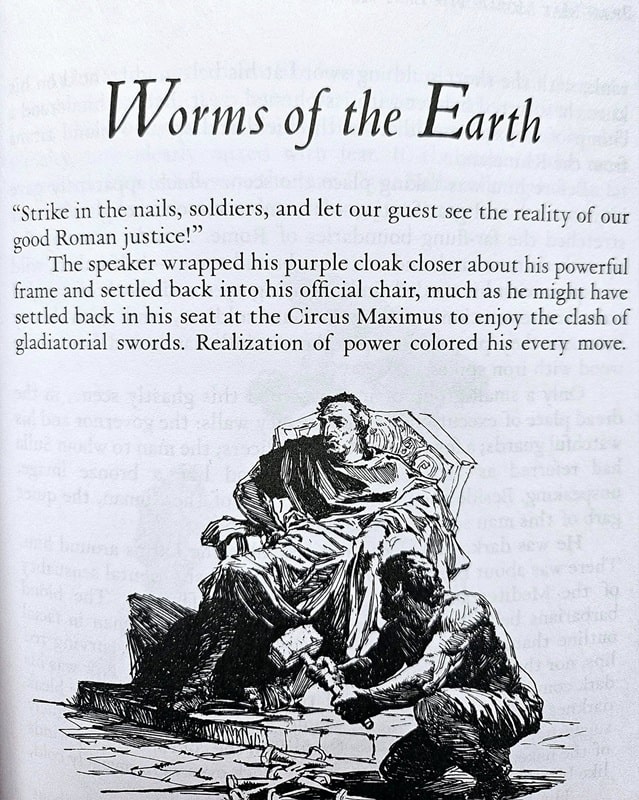
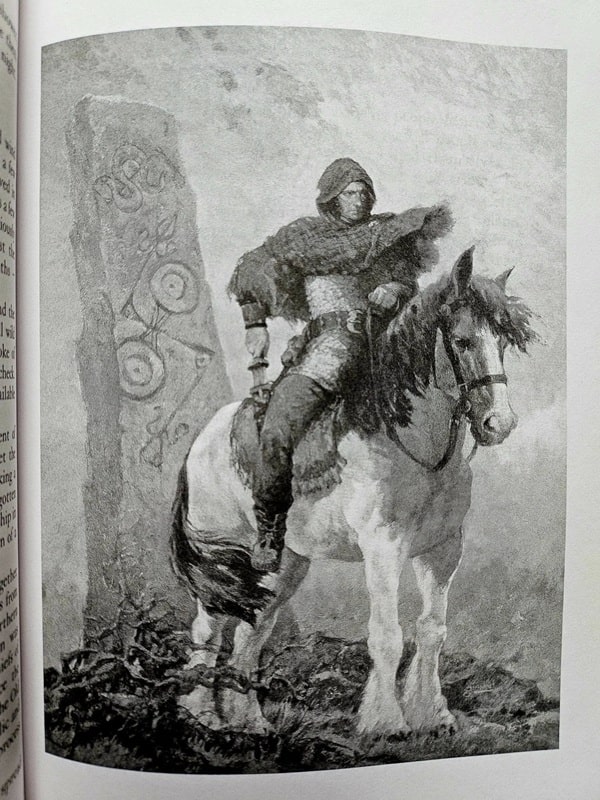
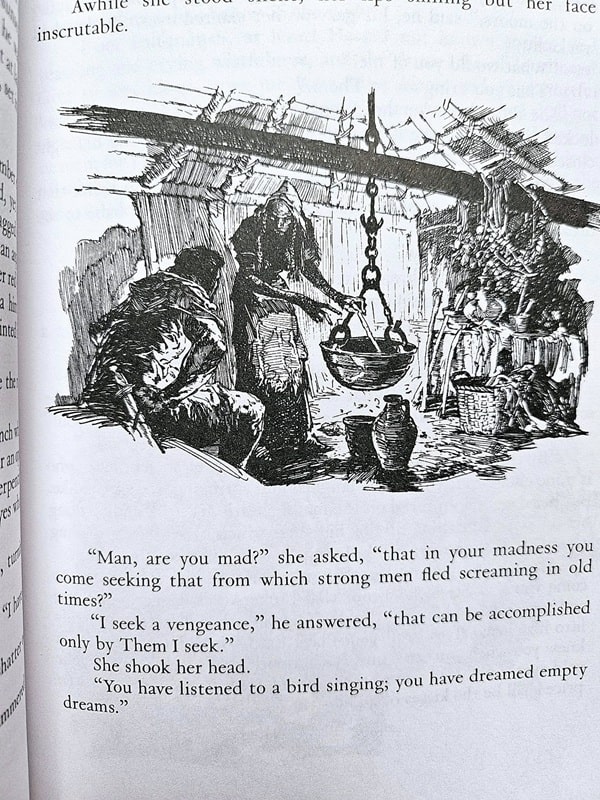
Art and layout from “The Worms in Earth,” published in
Bran Mak Morn: The Last King. Art by Gary Gianni
Of this story, REH said, “Only in my last Bran story, The Worms of the Earth… did I look through Pictish eyes, and speak with a Pictish tongue!”
The attached pictures feature art by Gary Gianni, from the Del Rey paperback, Bran Mak Morn, The Last King. His illustrations of the witch-woman, Atla, are particularly good.
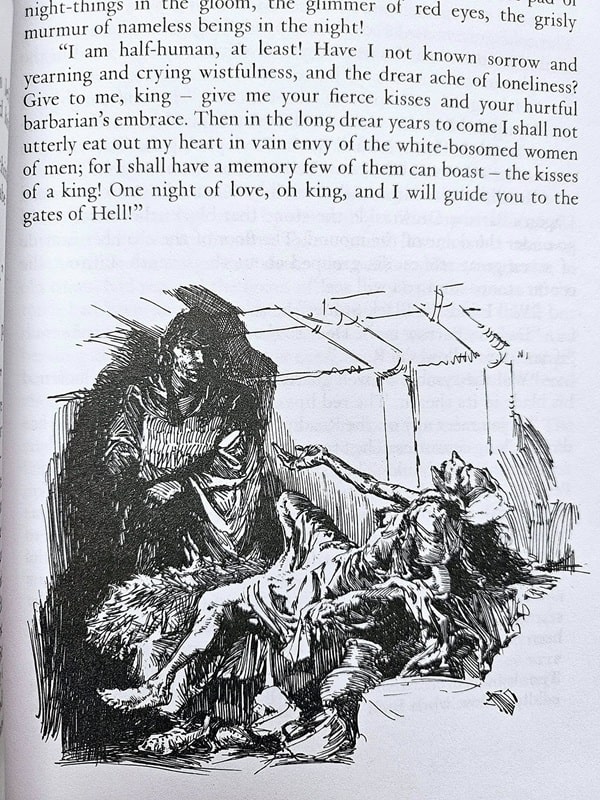
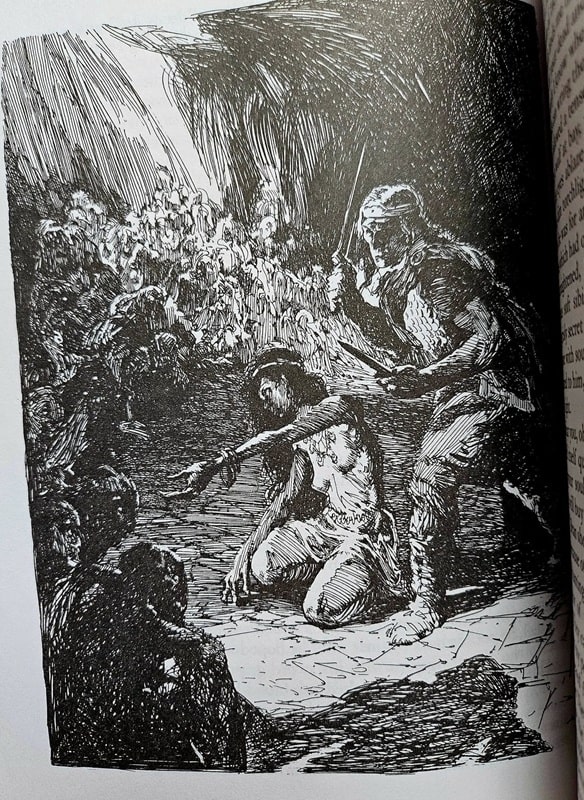
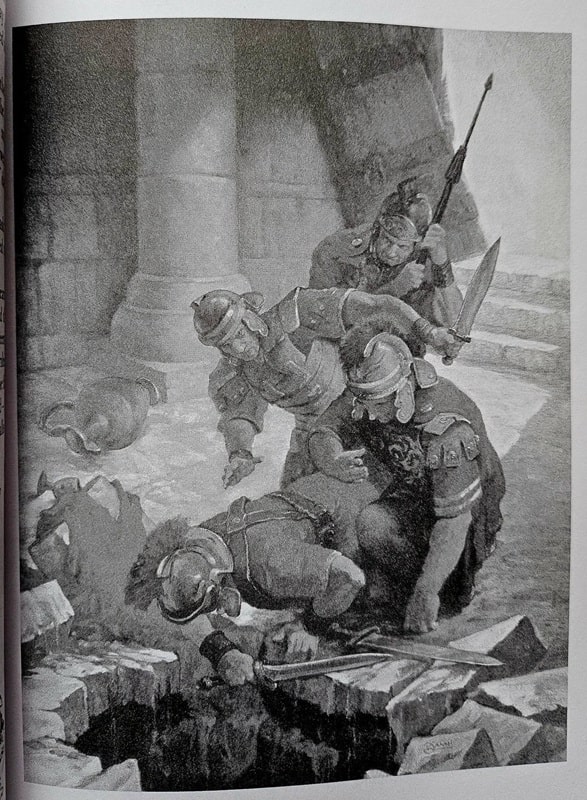
From “The Worms in Earth,” in Bran Mak Morn: The Last King
She was truly remarkable in the story, especially when she named her price for help to Bran:
What of my blasted and bitter life, I, whom mortal men loathe and fear? I have not known the love of men, the clasp of a strong arm, the sting of human kisses, I, Atla, the were-woman of the moors! What have I known but the lone winds of the fens, the dreary fire of cold sunsets, the whispering of the marsh grasses? – the faces that blink up at me in the waters of the meres, the foot-pad of night-things in the gloom, the glimmer of red eyes, the grisly murmur of nameless beings in the night!
I am half-human, at least! Have I not known sorrow and yearning and crying wistfulness, and the drear ache of loneliness? Give to me, king – give me your fierce kisses and your hurtful barbarian’s embrace. Then in the long drear years to come I shall not utterly eat out my heart in vain envy of the white-bosomed women of men; for I shall have a memory few of them can boast – the kisses of a king! One night of love, oh king, and I will guide you to the gates of Hell!
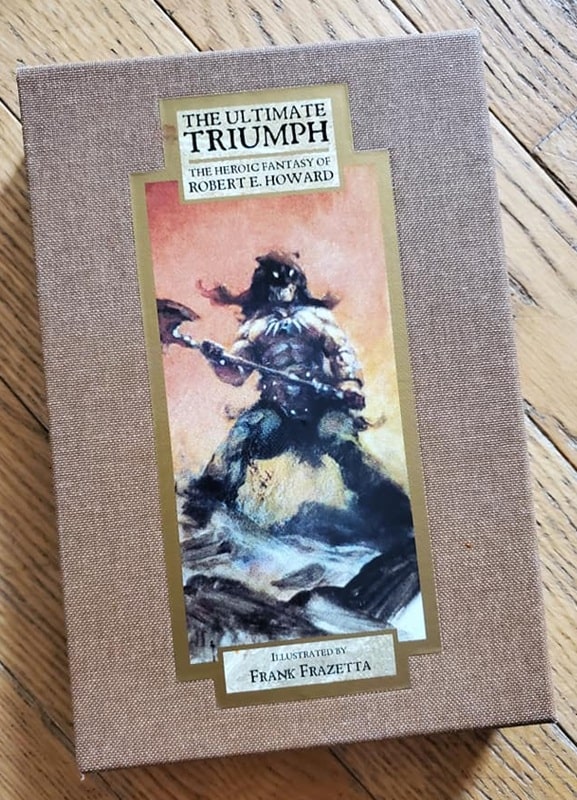
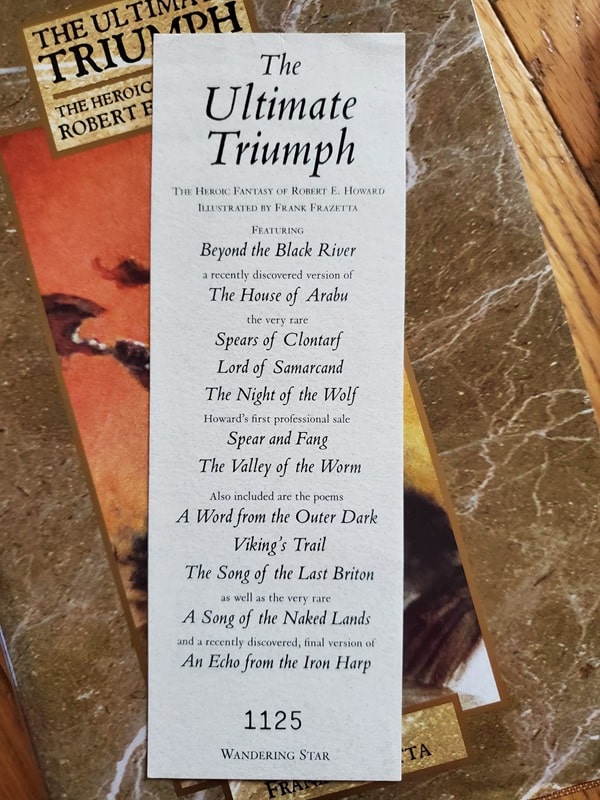
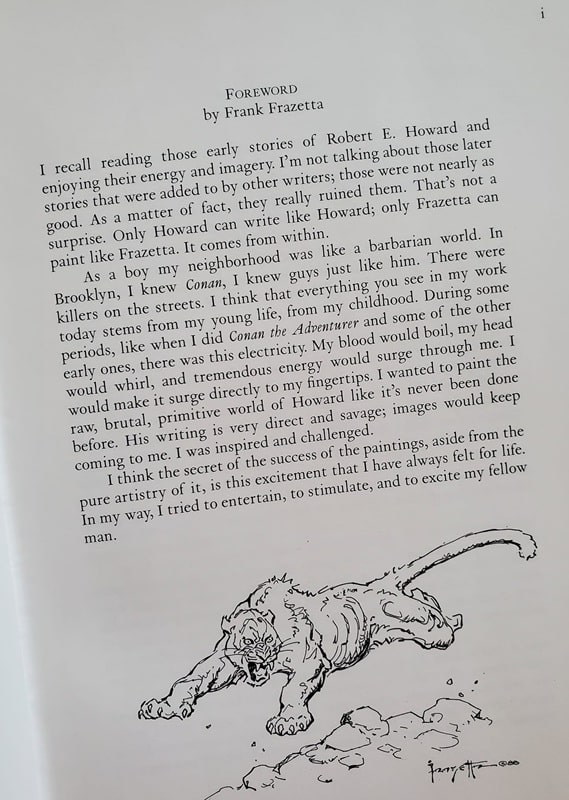
The Ultimate Triumph: The Heroic Fiction of Robert E. Howard
(Wandering Star, January 1, 1999). Art by Frank Frazetta.
The Ultimate Triumph ~ The Heroic Fiction of Robert E. Howard, illustrated by Frank Frazetta, is a prized treasure of mine, a gift that I received from my dear friend, Jim Goodwin.
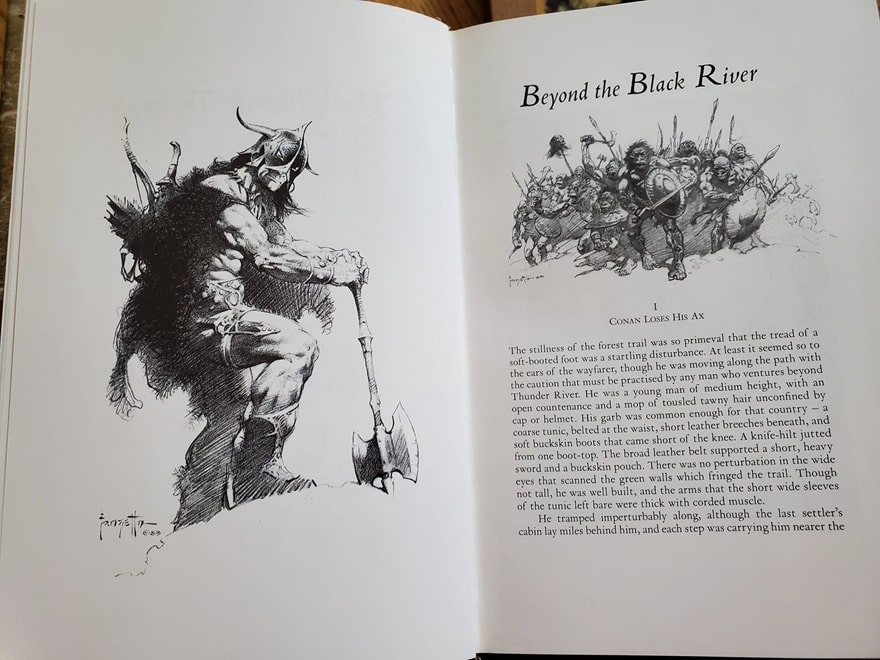 “Beyond the Black River,” in The Ultimate Triumph: The Heroic Fiction of Robert E. Howard. Art by Frazetta
“Beyond the Black River,” in The Ultimate Triumph: The Heroic Fiction of Robert E. Howard. Art by Frazetta
It features my favorite Conan story, “Beyond the Black River,” a recently discovered version of “The House of Arabu,” and several other rarities, poems, and one of my favorite letters that REH wrote to HPL regarding his stance on Civilization vs. Barbarism.
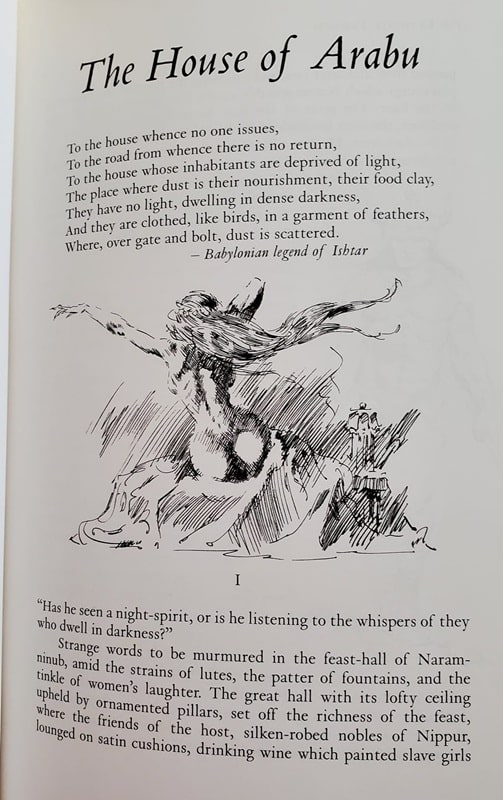
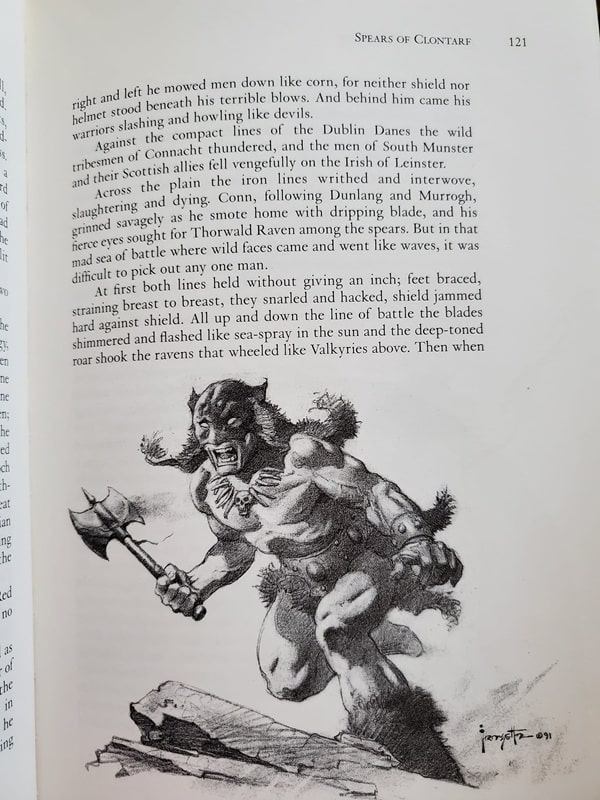
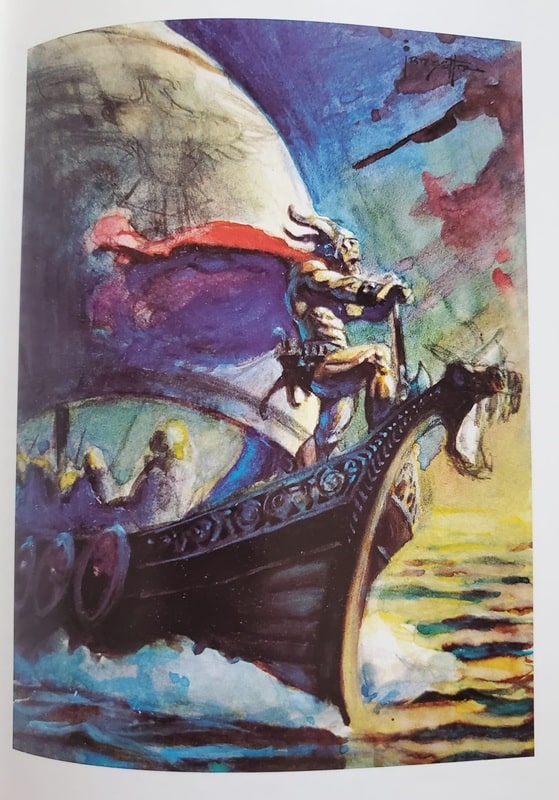
From The Ultimate Triumph: The Heroic Fiction of Robert E. Howard. Art by Frazetta
Sprinkled throughout this slipcased volume are incredible illustrations and paintings by the great Frank Frazetta. In fact, a foreword by Mr. Frazetta is also included, as well as an introduction by preeminent Howard scholar, Rusty Burke.
The title of this book is no misnomer, my friends — it truly is the ultimate triumph.
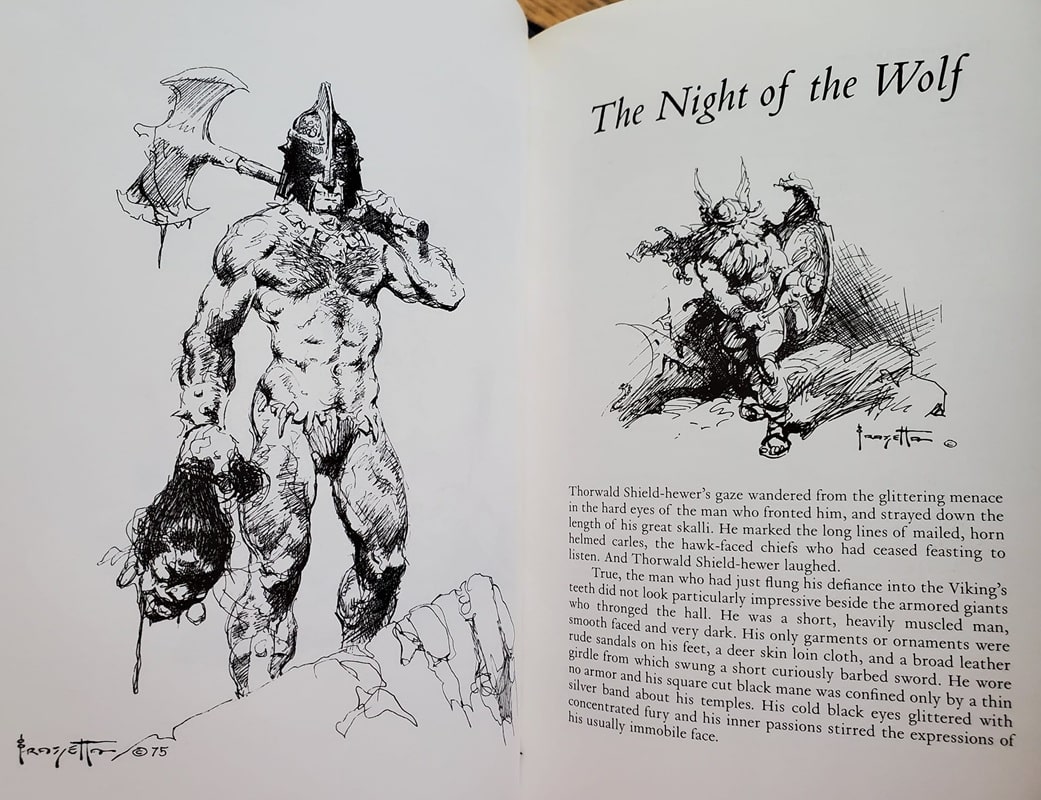
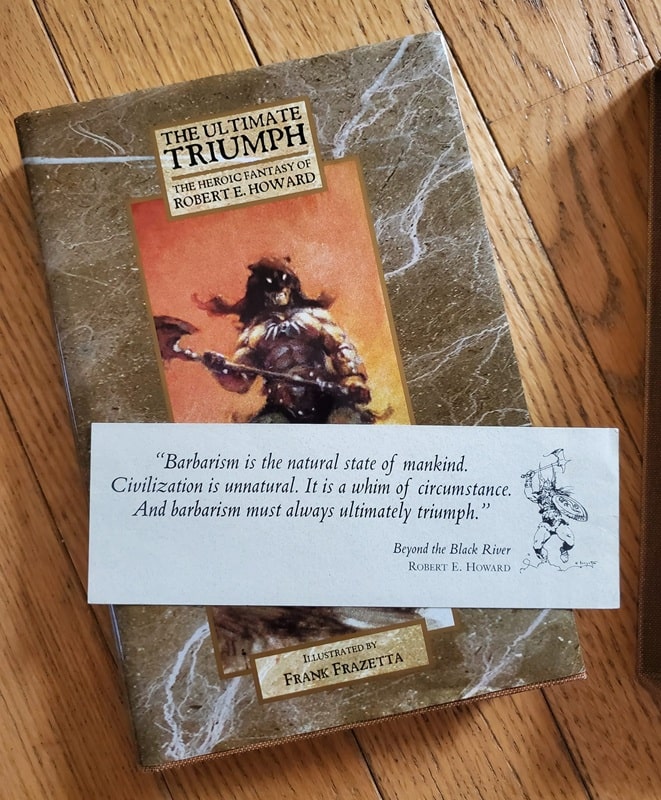
From The Ultimate Triumph: The Heroic Fiction of Robert E. Howard. Art by Frazetta
Robert E. Howard’s boxing stories may be his least read, because he’s so well known for Conan, Kull, Solomon Kane, Bran Mak Morn, El Borak, and several “Weird West” tales (a sub-genre that he is sometimes credited as the originator of).
But the boxing stories are excellent, too! They also include more humor than many of his other works (excepting the stories from A Gent from Bear Creek). Several of the “Sailor” Dennis Dorgan tales were not published during Robert’s lifetime, and those that were published were done so under his pseudonym, Patrick Ervin.
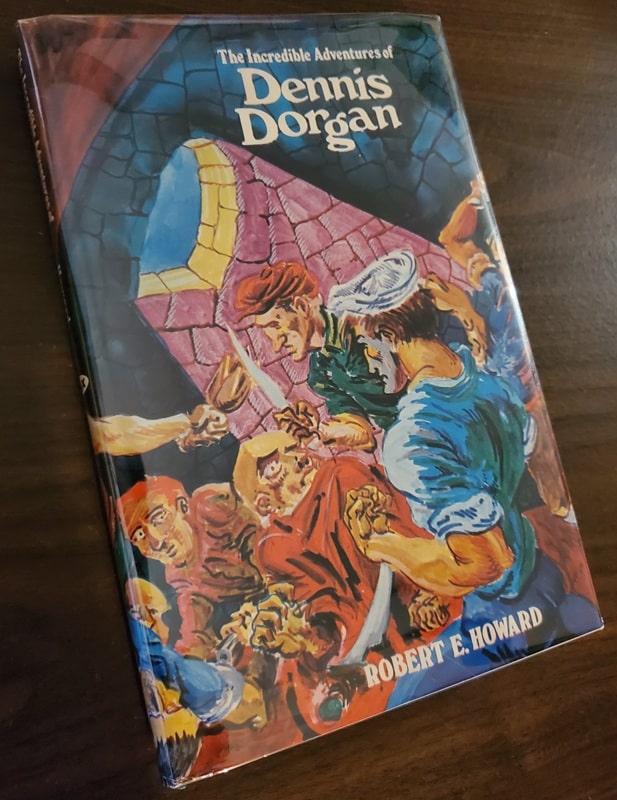 The Incredible Adventures of Dennis Dorgan (Fax Collector’s Editions, January 1, 1974))
The Incredible Adventures of Dennis Dorgan (Fax Collector’s Editions, January 1, 1974))
In December 2022 I received the download files for “The Black Stone,” by Robert E. Howard. This dramatic presentation, recorded by the inimitable H.P. Lovecraft Historical Society, may be (and please correct me if I’m wrong) the first time they have recorded an REH story. I couldn’t wait to listen to it! This is one of my favorite short stories.
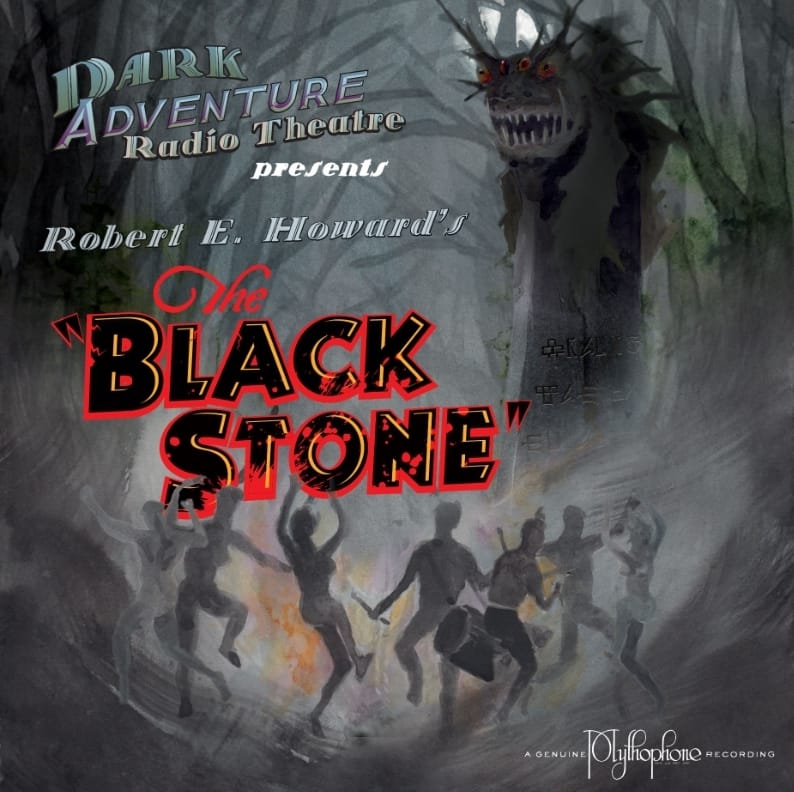 Robert E. Howard’s The Black Stone (H.P. Lovecraft Historical Society, December 2022)
Robert E. Howard’s The Black Stone (H.P. Lovecraft Historical Society, December 2022)
Robert E. Howard was an incredible innovator of sword-and-sorcery, weird fiction, horror, boxing, action/adventure, western, weird west stories, and more, as well as an equally impressive collection poems and verse. And he did almost all of it in a ten-year period from about age 20 to his passing at age 30, pounding away on an Underwood typewriter in a cramped, screened-in porch. I marvel at what he accomplished, and I wonder at what might have been.
If you are interested in the man and his life, I highly recommend Blood and Thunder, by Mark Finn.
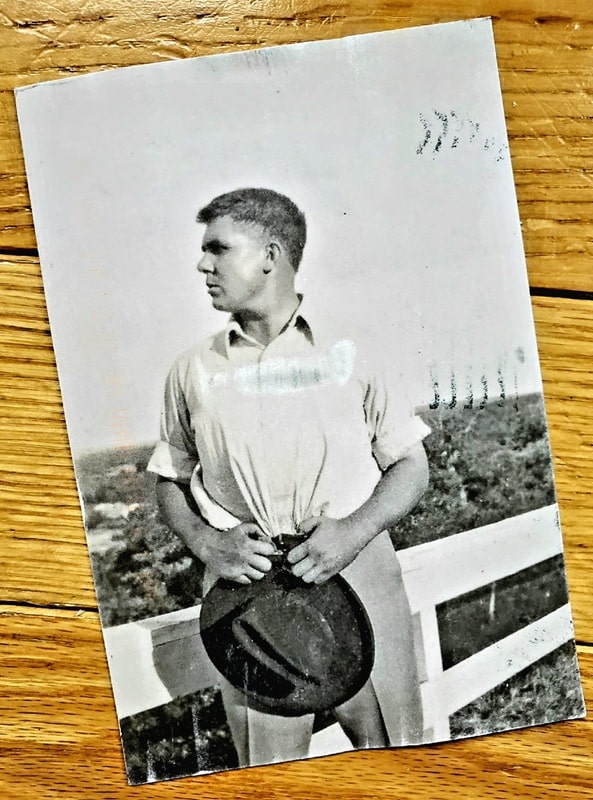
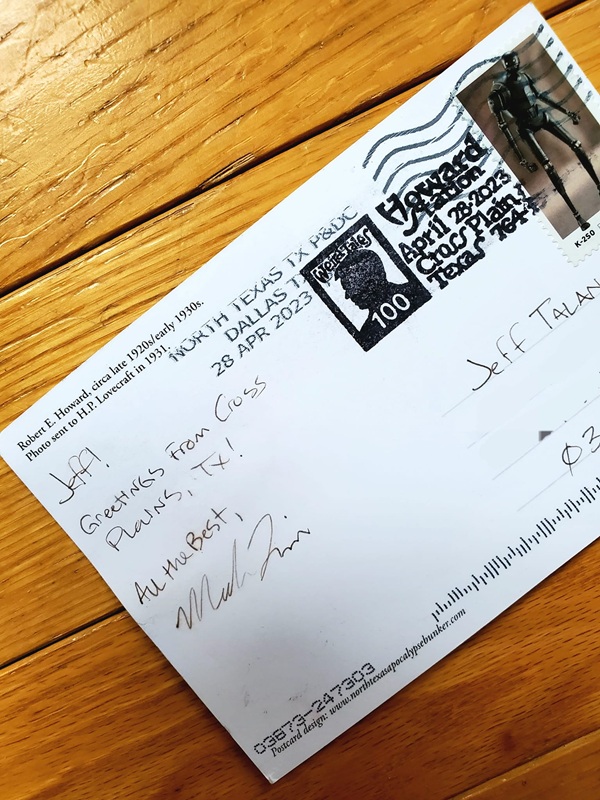
Robert E. Howard postcard
I never imagined that a postcard would be sent to me from Robert E. Howard’s home town of Cross Plains, TX. And during the 100-year anniversary of Weird Tales magazine, no less! I am ever grateful to my dog brother, Mark Finn, for making this possible.
I first met Mark after I’d read his stellar biography Blood & Thunder. I wanted to express my gratitude and appreciation for his incredible work, and I soon learned (surprise, surprise; or, “surprize,” as REH spelled it) that he was a fellow tabletop RPG enthusiast and comic book fan. So, thank you, Mark! By this postcard you rule!
Jeffrey P. Talanian’s last article for Black Gate was a review of The Eye of Sounnu by Schuyler Hernstrom. He is the creator and publisher of the Hyperborea sword-and-sorcery and weird science-fantasy RPG from North Wind Adventures. He was the co-author, with E. Gary Gygax, of the Castle Zagyg releases, including several Yggsburgh city supplements, Castle Zagyg: The East Mark Gazetteer, and Castle Zagyg: The Upper Works. Read Gabe Gybing’s interview with Jeffrey here, and follow his latest projects on Facebook and at www.hyperborea.tv.
Teaser Tuesdays - What Moves the Dead
Doing a reread of this book before reading What Feasts at Night.

The mushroom's gills were the deep-red color of severed muscle, the almost-violet shade that contrasts so dreadfully with the pale pink of viscera. I had seen it any number of times in dead deer and dying soldiers, but it startled me to see it here.
(page 1, What Moves the Dead by T. Kingfisher)
---------
Teaser Tuesdays is a weekly bookish meme, previously hosted by MizB of Should Be Reading. Anyone can play along! Just do the following: - Grab your current read - Open to a random page - Share two (2) “teaser” sentences from somewhere on that page BE CAREFUL NOT TO INCLUDE SPOILERS! (make sure that what you share doesn’t give too much away! You don’t want to ruin the book for others!) - Share the title & author, too, so that other TT participants can add the book to their TBR Lists if they like your teasers!
THE RADIANT KING by David Dalglish (Astral Kingdoms, 1)
Book Review: The Third Rule of Time Travel by Philip Fracassi
I received a review copy from the publisher. This does not affect the contents of my review and all opinions are my own.
 The Third Rule of Time Travel by Philip Fracassi
The Third Rule of Time Travel by Philip Fracassi
Mogsy’s Rating: 4 of 5 stars
Genre: Science Fiction
Series: Stand Alone
Publisher: Orbit (March 18, 2025)
Length: 325 pages
Author Information: Website
Time travel in science fiction has always been a fascinating yet challenging concept, teasing stories with endless potential while bringing its own unique set of headaches. Taking a bold step into this tricky domain of complex timelines and tangled paradoxes, Philip Fracassi brings us The Third Rule of Time Travel, a novel where the weight of memory and grief takes center stage.
The novel follows scientist Dr. Beth Darlow, who along with her late husband Colson had been developing a machine that allows the transport of the human consciousness through time and space. However, this form of time travel has limits. First, you can only travel within your own lifetime, so forget about going back to the dinosaurs or witnessing the fall of Rome. Second, there is no reliable way to know when and where your consciousness will end up, only that it can travel for no more than ninety seconds. Third, over the course of these ninety seconds, no interaction is possible, only observation. Due to the restraints on this particular tech, these three rules are immutable, with many mechanisms put in place to ensure that sending an individual’s consciousness to the past should not alter the present.
In the aftermath of Colson’s death, Beth is left to raise their young daughter on her own. She throws herself into her work, using the time machine to gather more data. But as the pressure mounts, her trips into the past become increasingly dangerous, with the machine seemingly to force her to relive her most traumatic moments. For Beth, whose life has been marked by plenty of grief—including the tragic loss of her parents and older sister in a plane crash during a childhood vacation, and Colson’s fatal car accident on her last her birthday—these painful memories threaten to shatter her. Then, a disturbing anomaly arises in the form of a discrepancy discovered between reality and the failsafe method designed to monitor changes in the present timeline. As the line between what is real and what is not begins to blur, Beth must do everything she can to hold onto her loved ones and her legacy.
Fracassi’s storytelling in The Third Rule of Time Travel is a riveting mix of fast-paced action punctuated by poignant, emotional beats. Tragedy has followed Beth since she was a kid, and the novel kicks off with a harrowing opening sequence, putting us in her head as her consciousness is transported to the worst moment of her life, as a way to introduce its time traveling elements. From this point onwards, the plot maintains strong momentum, keeping the interest going by making the reader care about Beth’s personal and professional life. The cutting-edge descriptions of the story’s time traveling method alongside the top-secret nature of the character’s work made it easy to keep turning the pages.
When it comes to characterization, Beth Darlow is a layered and sympathetic protagonist whose strength lies in her determination to keep living despite the recent loss of her husband, juggling both the important roles of scientist and now single mom. At home, she struggles with the guilt of hiring a nanny and having less time to spend with her daughter, while at work she seems to be constantly fighting time and funding constraints placed upon her by the company’s higher ups. But while this is undeniably Beth’s story, I feel that some of the supporting characters—the best friend, the research partner, the hard-ass boss, etc.—could have been better fleshed out to give the novel’s premise a more convincing boost.
There are also moments where this book stumbles under the weight of too much exposition, though going back to the complexities of time travel, I suppose a certain amount of info-dumping is to be expected. Most of these sections were thankfully brief and didn’t affect the pacing too much, and to his credit, Fracassi managed to get a lot of detail and explanation across without making it boring. Ultimately, the unique “three strict rules” imposed upon the author’s version of time traveling resulted in a thought-provoking read, emphasizing the psychological impotence one must experience when reliving a terrible life event with no power to change its course. That said, as is often the case with time travel stories, I didn’t feel like it stuck the landing. The climax and the ensuing confusion almost seemed intentional, as if discouraging you from overanalyzing and asking questions.
Still, at the end of the day, The Third Rule of Time Travel is a fresh and ambitious novel whose risks largely paid off. Despite a few minor stumbles here and there, the story managed to avoid major pitfalls that tend to plague hard science fiction time travel narratives—namely, the type of overly complicated or excessive minutiae that causes much frustration to readers. Overall, it was a worthwhile read that mades me appreciate the subgenre.
![]()
![]()
Monday Musings: My Big Brother
People often ask why Nancy and I moved to New York when we left the Appalachians. We could have settled pretty much anywhere, but we chose an area — the Hudson River Valley — that few think of as a retirement destination. The fact is, a main reason we came here was to be near my brother and sister-in-law, whom we adore.
 Jim and me, birding in Arizona.
Jim and me, birding in Arizona.
As it happens, this is my brother’s birthday week, and so I am afforded a wonderful opportunity to embarrass him.
James Coe — Jim to me; Jimmy when we were much younger — is just about my very favorite person in the world. He is older than I am. I won’t say by how much, but trust me, it’s A LOT!! When we were kids, I wanted to do everything he did, often to his dismay. He was my babysitter, my early-life mentor, occasionally my tormentor, but throughout all my years my best friend. He was the one who interested me (and our oldest brother, Bill) in birdwatching. He shaped my early musical tastes, introducing me to James Taylor, Joni Mitchell, the Beatles, Crosby Stills and Nash, Carole King, Simon and Garfunkel, not to mention the Monkees and Young Rascals. Later, as I got older, he was my guide to jazz. He saw to it that I discovered pizza. He risked parental sanction by lighting off firecrackers for my entertainment (and the satisfaction of his own pronounced pyromaniacal tendencies).
Jim is a remarkably talented artist — you can find samples of his work, as well as his very impressive biography, here — and all kidding aside, his courage in pursuing his own unconventional artistic career emboldened me to do something similar in pursuit of my passion for writing fantasy. In a sense, I owe my career to his example. His art is all over our walls, and for all of my adult life, the best gift I could receive for any birthday has been an original James Coe painting. Over the years, he has been incredibly generous in that regard.
He is a bold and creative chef, an accomplished baker whose from-scratch bread rivals Nancy’s (and that, my friends, is saying something). He is wise and caring, a wonderful Dad to his talented, beautiful children, Jonah and Rachel, a loving spouse to his spectacularly brilliant wife, Karen, and a marvelous uncle to our girls. He is, to this day, my favorite birding companion, my constant partner in silliness, my beloved big brother.
So, please wish Jim a happy birthday, and really do check out his website. He is annoyingly talented.
Love you, Coe.
Spotlight on “Gifted and Talented” by Olivie Blake
In Gifted and Talented, three siblings are forced to reckon with their long-festering rivalries, dangerous…
The post Spotlight on “Gifted and Talented” by Olivie Blake appeared first on LitStack.
Was Don Newcombe a Hall of Famer? – Spring means Baseball
 I have occasionally strayed off topic here at Black Gate, KISS, the Beach Boys, Humphrey Bogart…stuff like that. I played tee-ball as a tyke and have loved baseball my whole life. With a new season dawning (one in which my beloved Dodgers are the reigning World Series champs for the fourth time since I was born), I wanted to talk baseball. And I think that sharing about Don Newcombe is the way to do it.
I have occasionally strayed off topic here at Black Gate, KISS, the Beach Boys, Humphrey Bogart…stuff like that. I played tee-ball as a tyke and have loved baseball my whole life. With a new season dawning (one in which my beloved Dodgers are the reigning World Series champs for the fourth time since I was born), I wanted to talk baseball. And I think that sharing about Don Newcombe is the way to do it.
In 1949’s (sappy) It Happens Every Spring, Ray Milland’s chemistry professor suffers through his life half of the year, to get to baseball season.
Lord Tenneyson said ‘In the Spring a young man’s fancy lightly turns to thoughts of love.’ For a long time, it was baseball, not love, that young men thought of in American Spring.
When Spring Training would roll around in Florida (and then later, also in Arizona), I used to say “If they’re playing baseball somewhere, there’s till some hope for the world.” I’m not sure I believe that in these messed-up days. But the Dodgers (the epitome of a small-market, hard-working franchise, competing against big city, big money teams – HA HA HA) are working out and playing games in Arizona. It’s baseball season, which helps me ignore that my Ohio wind chill is 15 degrees right now.
The Dodgers and Yankees met in the World Series in 1947, 1949, 1952, 1953, 1955 and 1956. It was a glorious era for NYC baseball (and the Giants were a powerhouse as well), though Brooklyn managed to win only the 1955 matchup.
The greatest advantage that the Yankees had was their starting pitching. Whether it was Eddie Lopat, Allie Reynolds, Whitey Ford, Bob Kuzava or Don Larsen, the Bronx Bombers always seemed to come up with somebody in big moments (if not for Cookie Lavagetto, Bill Bevens would be included on that list).
 Rick Monday, Newcombe, Sandy Koufax, and Steve Garvey
Rick Monday, Newcombe, Sandy Koufax, and Steve Garvey
During this era, Don Newcombe rose above other Dodger would-be aces such as Carl Erskine, Ralph Branca and Johnny Podres (though the latter certainly carried the flag in the 1955 Series). Big Newk missed the 1952 and 1953 seasons, as he was serving his country, fighting in Korea. And his 1954 season was a poor one: it took him a year to get back to form after being released from service.
But from 1949-1951 and 1955-1956, Newcombe went a combined 103-40, with 92 complete games. Those are some impressive numbers for the 1949 Rookie of the Year.
However, he got a reputation as a choker in big games. He went all ten innings against the Phillies on the final day of the 1950 season, with the Dodgers needing a win to force a playoff. But he gave up a three run homer to Dick Sisler in the top of the tenth in the season-ending 4-1 loss (which would have been a win if third base coach Milt Stock had simply held Cal Abrams at third in the bottom of the ninth).
He carried a 4-1 lead into the ninth inning of that famous game three playoff against the Giants in 1951. But he couldn’t hold on and he had been relieved by Ralph Branca when Bobby Thomson hit the home run heard round the world.
And in three World Series’, he just couldn’t get the job done for the Dodgers. He started 5 games, going 0-4 with an ERA of 8.59 and lasting about 4 innings a start. Dominating regular season, poor post-season: Shades of a great lefty named Clayton Kershaw, several decades and thousands of miles West, later (Kershaw is my second-favorite Dodger, after Jackie Robinson).
In 1956, he won the (very first) Cy Young Award and the NL MVP, going 27-7. But in the World Series he couldn’t make it out of the second inning of game two or the fourth in game seven. His drinking more directly impacting his performance, as well as his shoulder wearing out from the overuse, his career was effectively done, and he went a combined 37-42 in the four years after that Cy Young season.
He spent 1961 in the minors and he finished in Japan in 1962, as a first baseman. Newcombe was a career.268 batter, with 7 homers in 1955. He could have been a major league hitter.
A Trailblazer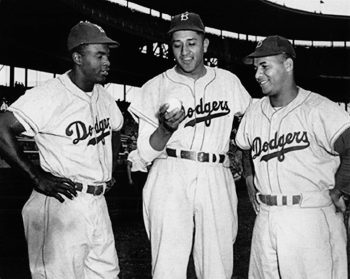 Newcombe was one of the first black players signed by the Dodgers. He and Roy Campanella played with Nashua of the New England League (B) in 1946. Newcombe returned there in 1947 (striking out 186), while Campanella played at AAA Montreal, and Jackie Robinson changed the world in Brooklyn.
Newcombe was one of the first black players signed by the Dodgers. He and Roy Campanella played with Nashua of the New England League (B) in 1946. Newcombe returned there in 1947 (striking out 186), while Campanella played at AAA Montreal, and Jackie Robinson changed the world in Brooklyn.
Newcombe was dominant in his two years at Nashua, going 33-10 with an ERA well under 3. He probably would have played in AA ball in 1947 but the Dodgers’ two AA teams were in the South and not yet ready to be integrated. Apparently AAA wasn’t the best option, as it had been for Robinson and Campanella.
In 1948 he went 17-6 at AAA Montreal (while Campy began his Hall of Fame career in Brooklyn). He threw his only no hitter, won three games in the first round of the International League Playoffs (losing another game 0-1), and then won a game in the Governor’s Cup series. He then went 1-1 as the Royals defeated the Dodgers’ other AAA team (St. Paul) for the Junior World Series. Newcombe dominated AAA.
He got called up to the Dodgers early in 1949. He was only the second black pitcher in the major leagues and the first good one (Dan Bankhead pitched in four games for the Dodgers in 1947).
Jackie Robinson deserves every praise and accolade. But Don Newcombe was the first man to prove an African-American could pitch in the major leagues. He hit 3 batters as a rookie, and 6 his third year. But there were no racial issues about a black pitcher hitting a white batter. It didn’t hurt that he was 6’-4”, 220. But his success, and his acceptance on the field, made him a pioneer, though he never received the credit he deserved for that.
Close to Cooperstown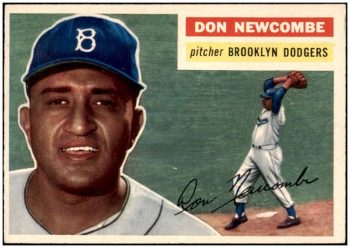 His raw numbers are lacking in HoF dazzle: 153-96, with a 3.57 ERA.
His raw numbers are lacking in HoF dazzle: 153-96, with a 3.57 ERA.
He does have one Rookie of the Year, one MVP, and one Cy Young award, along with one World Series ring, and he was a four-time All Star. That’s what is. But we can also look at a few ‘What ifs.’
There are four distinct elements of his career that might have changed his possible Hall of Fame path:
1) Newcombe’s first two seasons were spent with the Newark Eagles in the Negro Leagues. It’s fair to say that he might have developed more quickly with two years in the Dodgers’ system. But he was only 18 that first year. Maybe the hard experience of playing in the Negro Leagues had some benefits for him.
2) He lost a season, maybe two, to baseball’s color barrier. It’s a foregone conclusion that he would have done better than Dan Bankhead did. He was 17-8 with 19 complete games and a league-leading 5 shutouts as a 23 year-old rookie. That’s a pretty good start.
3) And he lost nearly two peak seasons to the Korean War. Plus his first year back was basically a lost one as well. He easily could have had three more 20 win/single-digit loss seasons.
Give him 60 more wins for the Korean War years, and there would be a dozen pitchers with fewer wins who are in the Hall of Fame, including two Dodgers (Don Drysdale, Dazzy Vance).
4) Finally, had Newcombe pitched better in the World Series (especially in 1956), he might well have continued on as one of the NL’s top pitchers, instead of spiraling deep into alcoholism.
With two more outs, it’s Newcombe, not Bobby Thomson, who is the hero of the 1951 NL playoff series (playoffs only occurred if two teams were tied at the end of the season. MLB did not adopt divisions and regular playoffs until 1969).
And with post-season success, the media might have lightened up (racism was certainly involved, but everyone loves a winner – somewhat). And he might have been more at ease if he wasn’t so clenched up inside from the criticism (Conversely, Newcombe was not appropriately praised for when he excelled, which he often did.).
That fourth factor (the postseason) was certainly within his control. But if the first three things had gone a bit differently, Don Newcombe might well be in the Hall of Fame today.
He and Justin Verlander are the only players to win the Rookie of the Year, Cy Young and MVP awards. That speaks volumes.
He Was Criticized Unjustly in the Press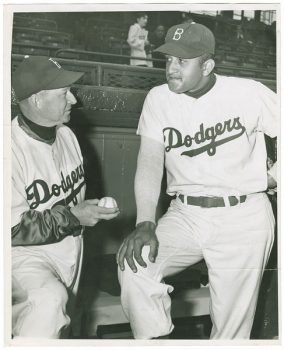 If you’ve read books about Jackie Robinson, you know the abuse that racist sportswriters (and fans, and players, and…) heaped upon him. Other early trailblazers like Newcombe were also the subject of vitriol. On September 14, 1951, Tommy Holmes of the Brooklyn Eagle – under the headline Is Newcombe Ailment a Case of Imaginatis? – wrote a scathing, rumor and innuendo-filled attack on Newcombe, which never would have been written about a white pitcher. Excerpts can be found in Jon Weisman’s book on Dodgers pitching, Brother in Arms. It’s a pathetic piece of non-objective ‘journalism’.
If you’ve read books about Jackie Robinson, you know the abuse that racist sportswriters (and fans, and players, and…) heaped upon him. Other early trailblazers like Newcombe were also the subject of vitriol. On September 14, 1951, Tommy Holmes of the Brooklyn Eagle – under the headline Is Newcombe Ailment a Case of Imaginatis? – wrote a scathing, rumor and innuendo-filled attack on Newcombe, which never would have been written about a white pitcher. Excerpts can be found in Jon Weisman’s book on Dodgers pitching, Brother in Arms. It’s a pathetic piece of non-objective ‘journalism’.
For example, Holmes asserts that ‘experts’ expected Newcombe to win 30 games that season, and instead of doing so, he was complaining about a sore arm. Dizzy Dean won 30 games in 1934. Exactly one pitcher has done so (that’s a good trivia question – go look it up) in the 90 seasons since. Holmes wrote an ‘uppity negro’ piece on Newcombe, and it was wrong in EVERY way.
As Chuck Dressen desperately tried to stop the Dodgers’ epic collapse (they led by 13 games in August), he kept throwing a tired (Newk led the team in innings pitched and had 18 complete games) and sore-armed Newcombe out there.
Newcombe started on September 17th, lasting only 6 and two-thirds. On the 22nd, he only made it 5 innings. On the 26h, he threw a complete game in a 15-5 win (you think Dressen couldn’t have given him a few innings off in a ten run win?). Only three days later on the 29th, it was a complete game shutout. And the very next day in the must-win season-finale, Dressen had him pitch 5 and two-thirds innings of relief. Big Newk gave up one hit and no runs as the Dodgers won 9-8, forcing the three-game playoff that made Bobby Thomson a baseball legend.
On only two days rest, after that heavy workload, Newcombe pitched 8 and one-third innings in that third-game loss. He had performed an even more impressive feat of carrying the team to the final day of the season the year before.
Holmes and other writers (and NYC baseball writers were celebrities in their day) wrote about Newcombe from their racist beliefs, not as objective observers. He was a workhorse who carried Dodgers teams to the brink of championships.
Alcoholism and RebirthNewcombe succumbed to life-long alcoholism. While he made the choice to drink, the unrelenting (and unreasonable) pressure he was subjected to, along with racist abuse, surely contributed to its severity. He declared bankruptcy in 1965 (he sold his World Series ring, which future Dodgers owner Peter O’Malley later bought and returned to him), and later divorced.
But he stopped drinking, straightened out his life, and was the Dodgers’ Director of Community Relations for over forty-five years, passing away in 2019. He became a leader in several organizations inside and outside of baseball, related to beating alcoholism.
Newcombe reflected on his career being cut short:
“I was only 34, but the alcohol had taken its toll. I think it shortened my major-league career by about six or seven years. I regret that I didn’t take better care of myself in the latter part of my career because I would like to have made the Hall of Fame, where I think I belong.”
Don Newcombe was haunted by his own demons, but found his own personal redemption. And with better handling on the Dodgers’ part; a few more seasons in the majors; and some more self-control, he could well be in Cooperstown today.
Newcombe recounted a conversation he had with Martin Luther King Jr.:
“Do you want to know what Jackie’s impact was? Well, let Martin Luther King tell you. In 1968, Martin had dinner in my house with my family. This was 28 days before he was assassinated. He said to me, ‘Don, I don’t know what I would have done without you guys setting up the minds for people for change. You, Jackie (Robinson) and Roy (Campanella) will never know how easy you made it for me to do my job.’ Can you imagine that? How easy we made it for Martin Luther King?”
He was an under-appreciated trailblazer, who rewrote his own personal story and played a major part in Dodgers’ history, on and off the field. And he wasn’t as far from a Hall of Fame career as one might think. It’s a shame no one worked with him to write a biography. It would have been a terrific book. He passed in 2019.

Bob Byrne’s ‘A (Black) Gat in the Hand’ made its Black Gate debut in 2018 and has returned every summer since.
His ‘The Public Life of Sherlock Holmes’ column ran every Monday morning at Black Gate from March, 2014 through March, 2017. And he irregularly posts on Rex Stout’s gargantuan detective in ‘Nero Wolfe’s Brownstone.’ He is a member of the Praed Street Irregulars, founded www.SolarPons.com (the only website dedicated to the ‘Sherlock Holmes of Praed Street’).
He organized Black Gate’s award-nominated ‘Discovering Robert E. Howard’ series, as well as the award-winning ‘Hither Came Conan’ series. Which is now part of THE Definitive guide to Conan. He also organized 2023’s ‘Talking Tolkien.’
He has contributed stories to The MX Book of New Sherlock Holmes Stories — Parts III, IV, V, VI, XXI, and XXXIII.
He has written introductions for Steeger Books, and appeared in several magazines, including Black Mask, Sherlock Holmes Mystery Magazine, The Strand Magazine, and Sherlock Magazine.
Review: The Raven Scholar by Antonia Hodgson

FORMAT/INFO: The Raven Scholar will be published on April 15th, 2025 by Orbit Books. It will be available in paperback, ebook, and audiobook formats.
OVERVIEW/ANALYSIS: Every 24 years, seven contenders from seven warrior temples match wits and blades in a series of trials designed to pick the next emperor of Orrun. It's a tradition that has largely ensured a peaceful transition of power for over 1500 years. But this year, one of the contestants is murdered on the eve of the competition. High Scholar Neema Kraa is charged with solving the murder, plunging her into a web of palace secrets. It isn't long before Neema realizes that people will kill to keep their secrets - and the only path to survival might be becoming emperor herself.
The Raven Scholar is an intricate, mesmerizing tangle of palace intrigue. This is a story with secrets upon secrets upon SECRETS. It's almost too many secrets, except that they are so carefully woven together, it makes the plot a delight to unwrap. Each revelation casts new light on past actions and motivations, while still keeping you guessing as to who the actual murderer is. If you're just here for the murder mystery alone, you'll have plenty to keep you entertained.
All of this is supported by the very deliberate pacing of the book. The Raven Scholar takes its time setting up the story. Lead character Neema Kraa doesn't arrive on the scene for multiple chapters, and the murder itself doesn't take place for well over 100 pages. But every chapter leading up to the murder is all in service of setting up the cast of characters, their relationships, and some very important recent historical events that personally affected everyone.
Most importantly, the story itself never drags, constantly making me want to read more. There are some doozy revelations that left me wide-eyed as I encountered the dark secrets in a character's past or realized the implication of new information. Again, it borders on too many things, but it's all so deftly woven together, it stopped short of feeling overstuffed.
I also applaud The Raven Scholar for being a story that is brutal and bloody without being gory and grim. Make no mistake, people will die and some very bad things will happen, but the author cuts away before it becomes too much. She also balances it out with a thread of humor strung throughout. Characters like the mischievous Fox warrior Cain or the ever dramatic Sol help break up the doom and gloom with some much needed levity.
I also have to shout out the magnificent use of the narrator in the story. While Neema is the lead character and the story is told in third person, this is being recounted to us by another. I won't spoil the surprise of who, but suffice to say it is deployed wonderfully. The bulk of the story follows Neema, but every now and then it swings away to follow other characters for a little bit, in a manner fully justified by the choice of narrator.
Neema herself is a scrappy, if brusque, lead. But most importantly, Neema is smart and she is competent, two of my favorite things in a protagonist. Her intellect and drive have made her one of the foremost scholars of her day. Unfortunately, her background of hailing from a backwater town prevents her from being able to easily navigate the political waters of the court. It's not that she doesn't understand the game, it's that the elite courtiers would rather shut her down than play the game with her at all, no matter how high she rises.
CONCLUSION: The Raven Scholar checks every box of things I love in a book. It has a compelling lead, a mystery that truly keeps you guessing, and a brutal competition for the throne. This is the kind of book that when I wasn't reading it, I was thinking about wanting to read it. I powered through the final 200 pages in one sitting because I simply couldn't stand dragging it out any longer. I had to inject this book into my veins as soon as possible, and now I'm staring at that most dreadful fate: waiting for the next book. But given how amazingly well done this first book was, I have every confidence that I will devour the sequel with equal speed.
The Leaning Pile of Books
The Leaning Pile of Books is a feature in which I highlight books I got over the last week that sound interesting—old or new, bought or received in the mail for review consideration. Since I hope you will find new books you’re interested in reading in these posts, I try to be as informative as possible. If I can find them, links to excerpts, author’s websites, and places where you can find more information on the book are included, along […]
The post The Leaning Pile of Books first appeared on Fantasy Cafe.Half a Century of Reading Tolkien: Part Three – The Two Towers by JRR Tolkien
 Gollum sat up again and looked at him under his eyelids. ‘He’s over there,’ he cackled. ‘Always there. Orcs will take you all the way. Easy to find Orcs east of the River. Don’t ask Sméagol. Poor, poor Sméagol, he went away long ago. They took his Precious, and he’s lost now.’
Gollum sat up again and looked at him under his eyelids. ‘He’s over there,’ he cackled. ‘Always there. Orcs will take you all the way. Easy to find Orcs east of the River. Don’t ask Sméagol. Poor, poor Sméagol, he went away long ago. They took his Precious, and he’s lost now.’
‘Perhaps we’ll find him again, if you come with us,’ said Frodo.
‘No, no, never! He’s lost his Precious,’ said Gollum.
Sméagol from The Taming of Sméagol of The Two Towers
When I was younger, The Two Towers (1954) seemed to suffer from middle-book syndrome: the bits after the start of series that had to be trudged through in order to reach the exciting end. Not all of it — it does feature a big battle complete with magic and explosives — but Frodo, Sam, and Smeagol’s trek to Mordor sometimes felt as arduous for me to read as it was for them to cross the swamp and slag heaps. Now, I believe The Two Towers, and the second half, The Ring Goes East, is the heart of the whole series. Nowhere does Prof. Tolkien speak more clearly on the weight of war, the burden and necessity of standing against evil, and the eroding effects of that duty.
The Two Towers has some of the most powerful writing in all the trilogy. There are several passages that have never failed to move me. That one of the most powerful of these lines was taken away from Sam carelessly given to Bad Faramir (more on that atrocity later), is one of the greatest crimes among the many I hold against Peter Jackson.
It’s the book of the trilogy that contains the most obvious references to Tolkien’s own service at the Somme in 1916. In the comments on my first article in this series, Half a Century of Reading Tolkien: Part One, K. Jespersen wrote that the books tasted of ashes, a flavor he linked directly to the First World War. I don’t tastes ashes in the books myself, but there are chapters redolent of them.
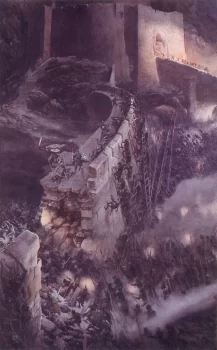 Battle of the Hornburg by Alan Lee
Battle of the Hornburg by Alan Lee
Again, for the uninitiated, a brief summary is in order. Following the disastrous events at the end of The Fellowship of the Ring, the Nine Walkers are split into three groups. Merry and Pippin, captured by a band of orcs, are dragged westward toward Isengard and Saruman. Frodo, with Sam insisting on accompanying, after Boromir’s attempt to seize the Ring, heads eastward toward Mordor and Mount Doom. Aragorn decides that Frodo and Sam might succeed on their own, but unless he, Legolas, and Gimli follow the other two hobbits, they will suffer torment and death.
The book’s first half, The Treason of Isengard, switches back and forth between Merry and Pippin’s travails, and Aragorn and his companions’ assorted adventures across Rohan. The two parties are reunited a week later after the return of Gandalf, the introduction of the Ents, great tree-like beings, and the Battle of the Hornburg (aka, the Battle of Helm’s Deep). The last is huge and murky in Peter Jackson’s film version, but on the page is tighter and far more tactically coherent.
The Ring Goes East, as I said, is the real heart of the trilogy. Frodo takes leave of his companions because he knows he must take the Ring to Mount Doom and that no one else can resist its malignant gravity. It also introduces Gollum/Sméagol. Gollum had been tracking the Nine Walkers from at least Moria, but he remained off stage. Now, he is captured and bound to Frodo after being made to swear on the Ring. Gollum, who calls the Ring his Precious, bore it for centuries. It twisted and hollowed him out, eating away at his mind and his soul. Now, he would do anything for its owner and, simultaneously, anything to repossess it.
Together, the trio cross the Dead Marshes, site of a great battle. Fought thousands of years before, images of the fallen, man, elf, and orc alike, linger on just below the surface of the marsh’s waters. Ghost lights flit over them, luring the unwary to their doom. Tolkien supposed that the battlefields of the Somme lived on in the Dead Marshes. He described how shell holes would be filled with water and the dead of both sides floated in them.
Clearing the swamps and finding Mordor’s main gate too formidable an obstacle, they head south to a secret way through the mountains Gollum claims can take them safely into Mordor. They meet their first men of Gondor, see an oliphaunt, witness the sallying forth of one of Sauron’s armies out of citadel so evil the ground around it is cursed, before starting on Gollum’s secret way. Things do not go well for any of them from there.
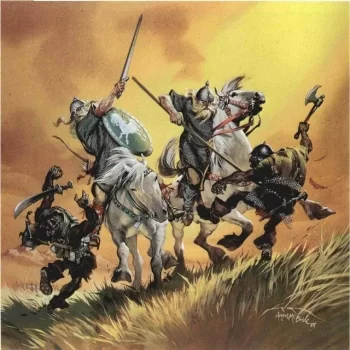 Riders of Rohan by Angus McBride
Riders of Rohan by Angus McBride
The Two Towers expands the reader’s vision of Middle-earth way beyond anything Tolkien displayed previously. The only human civilizations shown were the towns of Bree and Esgaroth. Now, we get to cross the expanse of the land of Rohan and meet its people, the Rohirrim. They been described as “Anglo-Saxon’s on horses,” which is reinforced with their Saxon-derived names such as Théoden, Éomer, and Éowyn.
Their horses were of great stature, strong and clean-limbed; their grey coats glistened, their long tails flowed in the wind, their manes were braided on their proud necks. The Men that rode them matched them well: tall and long-limbed; their hair, flaxen-pale, flowed under their light helms, and streamed in long braids behind them; their faces were stern and keen. In their hands were tall spears of ash, painted shields were slung at their backs, long swords were at their belts, their burnished shirts of mail hung down upon their knees.
It falls to the resurrected Gandalf to restore the king’s spirit so he can rouse his people and his forces against those of Saruman. Saruman once led the White Council against the resurgence of Sauron, but he came to betray them. Now he plans to conquer Rohan, Gondor’s only ally, and seize the Ring for himself.
And rouse the king, Gandalf does, which means we get one of Tolkien’s great epic moments. He doesn’t always show you the action in the books. We get the death of Boromir, Gandalf’s battle against the balrog, and the destruction of Isengard all second hand. Not this time. Instead, we get s brutal night battle against terrible odds and in harrowing detail, alleviated only a little by Gimli and Legolas’s banter over who’s killed more enemies.
It was now past midnight. The sky was utterly dark, and the stillness of the heavy air foreboded storm. Suddenly the clouds were seared by a blinding flash. Branched lightning smote down upon the eastward hills. For a staring moment the watchers on the walls saw all the space between them and the Dike lit with white light: it was boiling and crawling with black shapes, some squat and broad, some tall and grim, with high helms and sable shields. Hundreds and hundreds more were pouring over the Dike and through the breach. The dark tide flowed up to the walls from cliff to cliff. Thunder rolled in the valley. Rain came lashing down.
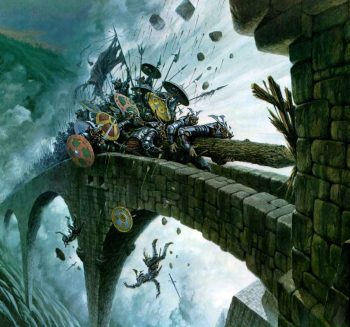 The Battle of Helm’s Deep by Darrell K Sweet
The Battle of Helm’s Deep by Darrell K Sweet
Arrows thick as the rain came whistling over the battlements, and fell clinking and glancing on the stones. Some found a mark. The assault on Helm’s Deep had begun, but no sound or challenge was heard within; no answering arrows came.
The assailing hosts halted, foiled by the silent menace of rock and wall. Ever and again the lightning tore aside the darkness. Then the Orcs screamed, waving spear and sword, and shooting a cloud of arrows at any that stood revealed upon the battlements; and the men of the Mark amazed looked out, as it seemed to them, upon a great field of dark corn, tossed by a tempest of war, and every ear glinted with barbed light.
Brazen trumpets sounded. The enemy surged forward, some against the Deeping Wall, others towards the causeway and the ramp that led up to the Hornburg-gates. There the hugest Orcs were mustered, and the wild men of the Dunland fells. A moment they hesitated and then on they came. The lightning flashed, and blazoned upon every helm and shield the ghastly hand of Isengard was seen. They reached the summit of the rock; they drove towards the gates.
Then at last an answer came: a storm of arrows met them, and a hail of stones. They wavered, broke, and fled back; and then charged again, broke and charged again; and each time, like the incoming sea, they halted at a higher point. Again trumpets rang, and a press of roaring men leaped forth. They held their great shields above them like a roof, while in their midst they bore two trunks of mighty trees. Behind them orc-archers crowded, sending a hail of darts against the bowmen on the walls. They gained the gates. The trees, swung by strong arms, smote the timbers with a rending boom. If any man fell, crushed by a stone hurtling from above, two others sprang to take his place. Again and again the great rams swung and crashed.
The Treason of Isengard was probably my favorite part of The Lord of the Rings when I was young. It’s got action and adventure and lots and lots of cool things. I remember me and my dad debating exactly what Orthanc and Meduseld looked like. Gandalf reappears and we learn about the palantír. The reunion of Merry and Pippin with Gandalf and company in Isengard is one of the funniest moments in the books. It all terrific, but it’s in The Ring Goes East, though, where the deepest themes of The Lord of Rings are developed.
Frodo and Sam march off toward Mordor knowing they probably won’t return, but they know it must be done. Defending what is right comes with a cost that leaves no one unchanged. It is too easy to fall in love with bloody deeds for themselves and forsake the things that might be lost.
In the middle of an attack by a band of Gondorian rangers on a force of enemy soldier, Sam meets the enemy up close for the first time.
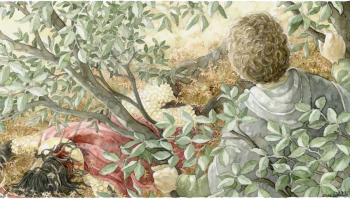 The Fallen Southron by Anke Eißmann
The Fallen Southron by Anke Eißmann
Sam, eager to see more, went now and joined the guards. He scrambled a little way up into one of the larger of the bay-trees. For a moment he caught a glimpse of swarthy men in red running down the slope some way off with green-clad warriors leaping after them, hewing them down as they fled. Arrows were thick in the air. Then suddenly straight over the rim of their sheltering bank, a man fell, crashing through the slender trees, nearly on top of them. He came to rest in the fern a few feet away, face downward, green arrow-feathers sticking from his neck below a golden collar. His scarlet robes were tattered, his corslet of overlapping brazen plates was rent and hewn, his black plaits of hair braided with gold were drenched with blood. His brown hand still clutched the hilt of a broken sword.
It was Sam’s first view of a battle of Men against Men, and he did not like it much. He was glad that he could not see the dead face. He wondered what the man’s name was and where he came from; and if he was really evil of heart, or what lies or threats had led him on the long march from his home; and if he would not really rather have stayed there in peace –
To take these words and give them to anyone other than an innocent gardener from the Shire is practically sacrilegious. I imagine this is how Tolkien must have felt on seeing his first dead Germans in the mud of the front. These words are at the core of the humanist heart of the books. War is a engine that sucks men in and grinds out corpses. It might be necessary, but it is horrible and not something to be cherished as many in Gondor have come to. Instead, the value of what is being defended must never be forgotten.
‘For myself,’ said Faramir, ‘I would see the White Tree in flower again in the courts of the kings, and the Silver Crown return, and Minas Tirith in peace: Minas Anor again as of old, full of light, high and fair, beautiful as a queen among other queens: not a mistress of many slaves, nay, not even a kind mistress of willing slaves. War must be, while we defend our lives against a destroyer who would devour all; but I do not love the bright sword for its sharpness, nor the arrow for its swiftness, nor the warrior for his glory. I love only that which they defend: the city of the Men of Númenor; and I would have her loved for her memory, her ancientry, her beauty, and her present wisdom. Not feared, save as men may fear the dignity of a man, old and wise.
In The Hobbit, Gollum was simply a twisted little monster below Goblin Town who riddled with Bilbo. Here, he’s become Sméagol again, a pathetic creature torn apart by possessing the Ring for so many years and the hold it still holds over him. Not much of Sméagol remains after five hundred years of possessing the Ring, and as he describes it, that part of himself went away a long time ago. When Sméagol is first captured, Frodo recalls the words of Gandalf about how Bilbo’s was stayed by pity and mercy from slaying Gollum and finds the same pity in his own heart. Come the third book, The Return of the King, even after Sméagol has betrayed them and tried to kill them, Sam can’t bring himself to kill him. He’s enough of a tragic creature that Tolkien is able to convince Frodo, and more importantly, the reader, that he might still be something worth saving.
Frodo and Sam are the most developed characters in the trilogy. Tolkien doesn’t go in for all that much interiority with any of the other characters in his books. From their conversations and from their thoughts, Frodo and Sam take on much more life than anyone else. Together, they get to express one of the most profound things in The Lord of the Rings.
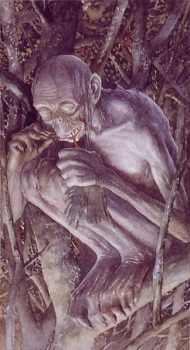 Gollum by Alan Lee
Gollum by Alan Lee
‘And we shouldn’t be here at all, if we’d known more about it before we started. But I suppose it’s often that way. The brave things in the old tales and songs, Mr. Frodo: adventures, as I used to call them. I used to think that they were things the wonderful folk of the stories went out and looked for, because they wanted them, because they were exciting and life was a bit dull, a kind of a sport, as you might say. But that’s not the way of it with the tales that really mattered, or the ones that stay in the mind. Folk seem to have been just landed in them, usually – their paths were laid that way, as you put it. But I expect they had lots of chances, like us, of turning back, only they didn’t. And if they had, we shouldn’t know, because they’d have been forgotten. We hear about those as just went on – and not all to a good end, mind you; at least not to what folk inside a story and not outside it call a good end. You know, coming home, and finding things all right, though not quite the same – like old Mr. Bilbo. But those aren’t always the best tales to hear, though they may be the best tales to get landed in! I wonder what sort of a tale we’ve fallen into?’
‘I wonder,’ said Frodo. ‘But I don’t know. And that’s the way of a real tale. Take any one that you’re fond of. You may know, or guess, what kind of a tale it is, happy-ending or sad-ending, but the people in it don’t know. And you don’t want them to.’
‘No, sir, of course not. Beren now, he never thought he was going to get that Silmaril from the Iron Crown in Thangorodrim, and yet he did, and that was a worse place and a blacker danger than ours. But that’s a long tale, of course, and goes on past the happiness and into grief and beyond it – and the Silmaril went on and came to Eärendil. And why, sir, I never thought of that before! We’ve got – you’ve got some of the light of it in that star-glass that the Lady gave you! Why, to think of it, we’re in the same tale still! It’s going on. Don’t the great tales never end?’
‘No, they never end as tales,’ said Frodo. ‘But the people in them come, and go when their part’s ended. Our part will end later – or sooner.’
 At the Cross Roads by Ted Nasmith
At the Cross Roads by Ted Nasmith
I love Sam’s realization that he personally is an appendix to a tale going back thousands of years. He’s reached this wonderful understanding that he’s in the middle of a story and then it suddenly occurs to him that he’s not even in his own story, but just one more leg on someone else’s. Of course all this gets mangled and bastardized in the movie.
Which brings me to Peter Jackson’s movie, which feels very much like someone other than Tolkien’s story. I’ll only bring up a few of the things that leave me enraged watching his The Two Towers. The easiest one is which two towers the title refers to. The book’s title refers to Orthanc and Minas Morgul. Instead, Jackson has Saruman deliver a line about a new power made of the union of two towers, by which he means Orthanc and Barad Dur. I don’t know if I can say it’s an important thing, but I can say it’s an annoying thing.
Aside from Aragorn falling off a cliff, more bad jokes — dwarf tossing (again!), bad soup, and others — and buffoonishness from Merry and Pippin, there’s the case of Bad Faramir. In the book, Faramir is a throwback to the noblest Men of the West. Unlike his brother Boromir, he fights for the good things, not for the accolades or the desire to perform heroic deeds. He is not tempted by the Ring and helps the hobbits on their way.
Jackson’s Faramir, like Aragorn before him, can’t simply be a hero. He must be flawed and learn something or other before he can achieve his heroic status. That neither he, nor Boromir, are fair skinned with dark hair only makes matters worse.
I’m not that thrilled with how the Battle of Helm’s Deep is handled in the film. In the book, Théoden brings his forces to the fortress for clearly laid out strategic reasons. Here, it’s made out to be some sort of foolish, poorly thought out action. Aragorn argues with him about sending out messengers for aid, something no one in the book would imagine saying for a moment.
The battle never seems as desperate or grim as Tolkien makes it out to be (Haldir, the elf with the five o’clock shadow, getting killed doesn’t count because he’s barely a character). I struggle to image Orlando Bloom’s Legolas acting like this:
He climbed up and found Legolas beside Aragorn and Éomer. The elf was whetting his long knife. There was for a while a lull in the assault, since the attempt to break in through the culvert had been foiled.
‘Twenty-one!’ said Gimli.
‘Good!’ said Legolas. ‘But my count is now two dozen. It has been knife-work up here.’
I can’t bring myself to say anything else about the movie. Yes, we do get to see the Ents destroy Isengard, but even that’s not as cool looking as it’s described in the book. I’m so sick and tired of whining Frodo and the scene with the Ring Wraith and then him threatening Sam makes me nuts. I just tried to watch the animated War of the Rohirrim and I think something broke in my head.
I guess the only thing to do now that I’ve finished The Lord of the Rings is to go to The Silmarillion, The Hobbit, or….Bored of the Rings. Whichever I choose, it’s guaranteed to wash away some of the pain of Jackson’s movie.
Half a Century of Reading Tolkien: Part One
Half a Century of Reading Tolkien: Part Two – The Fellowship of the Ring by JRR Tolkien
Fletcher Vredenburgh writes a column each first Sunday of the month at Black Gate, mostly about older books he hasn’t read before. He also posts at his own site, Stuff I Like when his muse hits him.


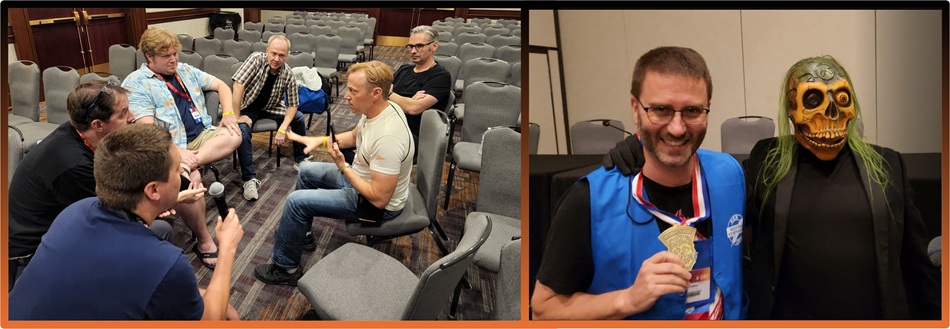
Recent comments